Occupational Health and safety
VerifiedAdded on 2022/08/26
|30
|6731
|49
AI Summary
Contribute Materials
Your contribution can guide someone’s learning journey. Share your
documents today.

Occupational Health and safety (OHS)
Assessment Booklet 2
Assessment Task 3 – short answer questions
Assessment Booklet 2
Assessment Task 3 – short answer questions
Secure Best Marks with AI Grader
Need help grading? Try our AI Grader for instant feedback on your assignments.
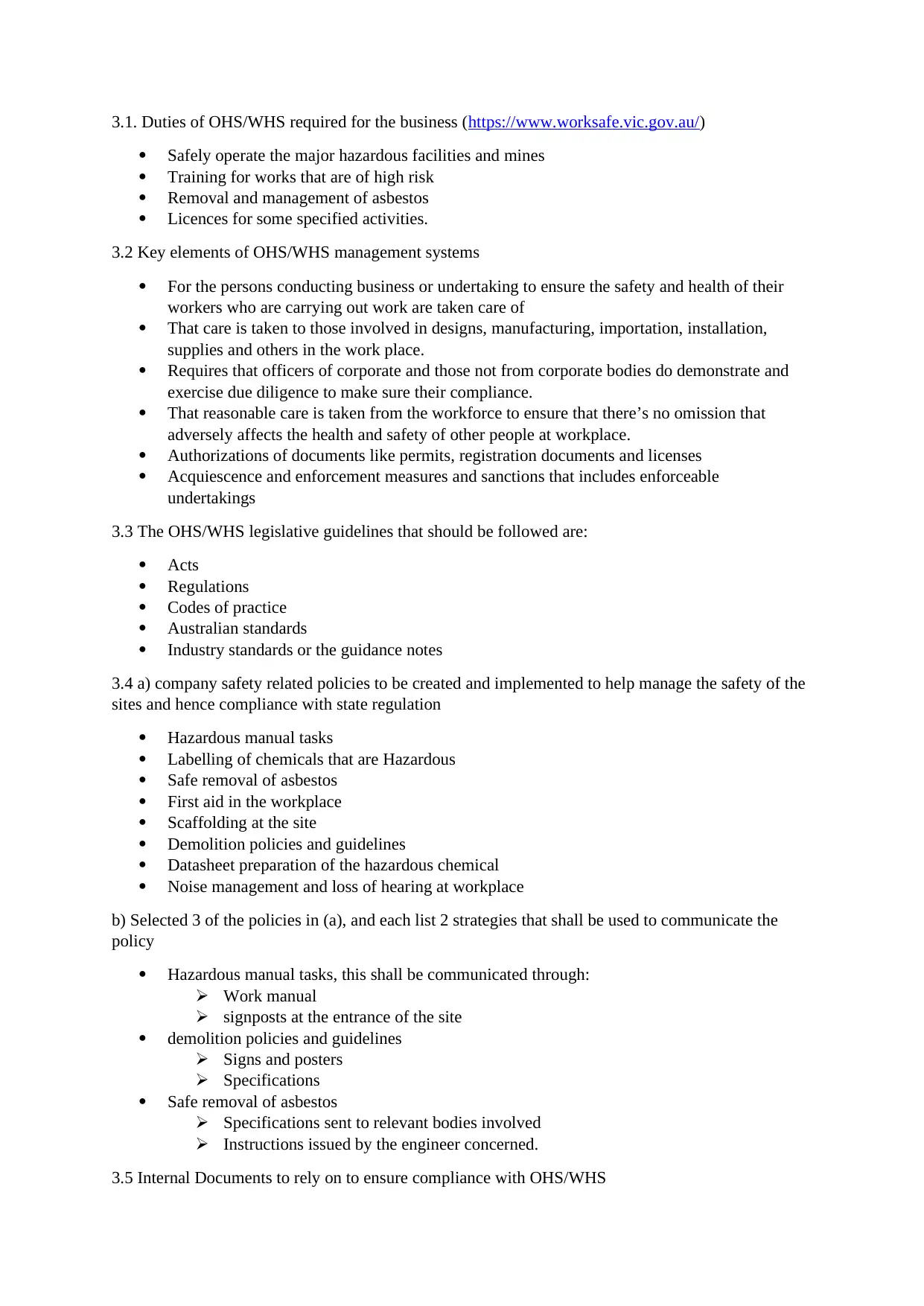
3.1. Duties of OHS/WHS required for the business (https://www.worksafe.vic.gov.au/)
Safely operate the major hazardous facilities and mines
Training for works that are of high risk
Removal and management of asbestos
Licences for some specified activities.
3.2 Key elements of OHS/WHS management systems
For the persons conducting business or undertaking to ensure the safety and health of their
workers who are carrying out work are taken care of
That care is taken to those involved in designs, manufacturing, importation, installation,
supplies and others in the work place.
Requires that officers of corporate and those not from corporate bodies do demonstrate and
exercise due diligence to make sure their compliance.
That reasonable care is taken from the workforce to ensure that there’s no omission that
adversely affects the health and safety of other people at workplace.
Authorizations of documents like permits, registration documents and licenses
Acquiescence and enforcement measures and sanctions that includes enforceable
undertakings
3.3 The OHS/WHS legislative guidelines that should be followed are:
Acts
Regulations
Codes of practice
Australian standards
Industry standards or the guidance notes
3.4 a) company safety related policies to be created and implemented to help manage the safety of the
sites and hence compliance with state regulation
Hazardous manual tasks
Labelling of chemicals that are Hazardous
Safe removal of asbestos
First aid in the workplace
Scaffolding at the site
Demolition policies and guidelines
Datasheet preparation of the hazardous chemical
Noise management and loss of hearing at workplace
b) Selected 3 of the policies in (a), and each list 2 strategies that shall be used to communicate the
policy
Hazardous manual tasks, this shall be communicated through:
Work manual
signposts at the entrance of the site
demolition policies and guidelines
Signs and posters
Specifications
Safe removal of asbestos
Specifications sent to relevant bodies involved
Instructions issued by the engineer concerned.
3.5 Internal Documents to rely on to ensure compliance with OHS/WHS
Safely operate the major hazardous facilities and mines
Training for works that are of high risk
Removal and management of asbestos
Licences for some specified activities.
3.2 Key elements of OHS/WHS management systems
For the persons conducting business or undertaking to ensure the safety and health of their
workers who are carrying out work are taken care of
That care is taken to those involved in designs, manufacturing, importation, installation,
supplies and others in the work place.
Requires that officers of corporate and those not from corporate bodies do demonstrate and
exercise due diligence to make sure their compliance.
That reasonable care is taken from the workforce to ensure that there’s no omission that
adversely affects the health and safety of other people at workplace.
Authorizations of documents like permits, registration documents and licenses
Acquiescence and enforcement measures and sanctions that includes enforceable
undertakings
3.3 The OHS/WHS legislative guidelines that should be followed are:
Acts
Regulations
Codes of practice
Australian standards
Industry standards or the guidance notes
3.4 a) company safety related policies to be created and implemented to help manage the safety of the
sites and hence compliance with state regulation
Hazardous manual tasks
Labelling of chemicals that are Hazardous
Safe removal of asbestos
First aid in the workplace
Scaffolding at the site
Demolition policies and guidelines
Datasheet preparation of the hazardous chemical
Noise management and loss of hearing at workplace
b) Selected 3 of the policies in (a), and each list 2 strategies that shall be used to communicate the
policy
Hazardous manual tasks, this shall be communicated through:
Work manual
signposts at the entrance of the site
demolition policies and guidelines
Signs and posters
Specifications
Safe removal of asbestos
Specifications sent to relevant bodies involved
Instructions issued by the engineer concerned.
3.5 Internal Documents to rely on to ensure compliance with OHS/WHS
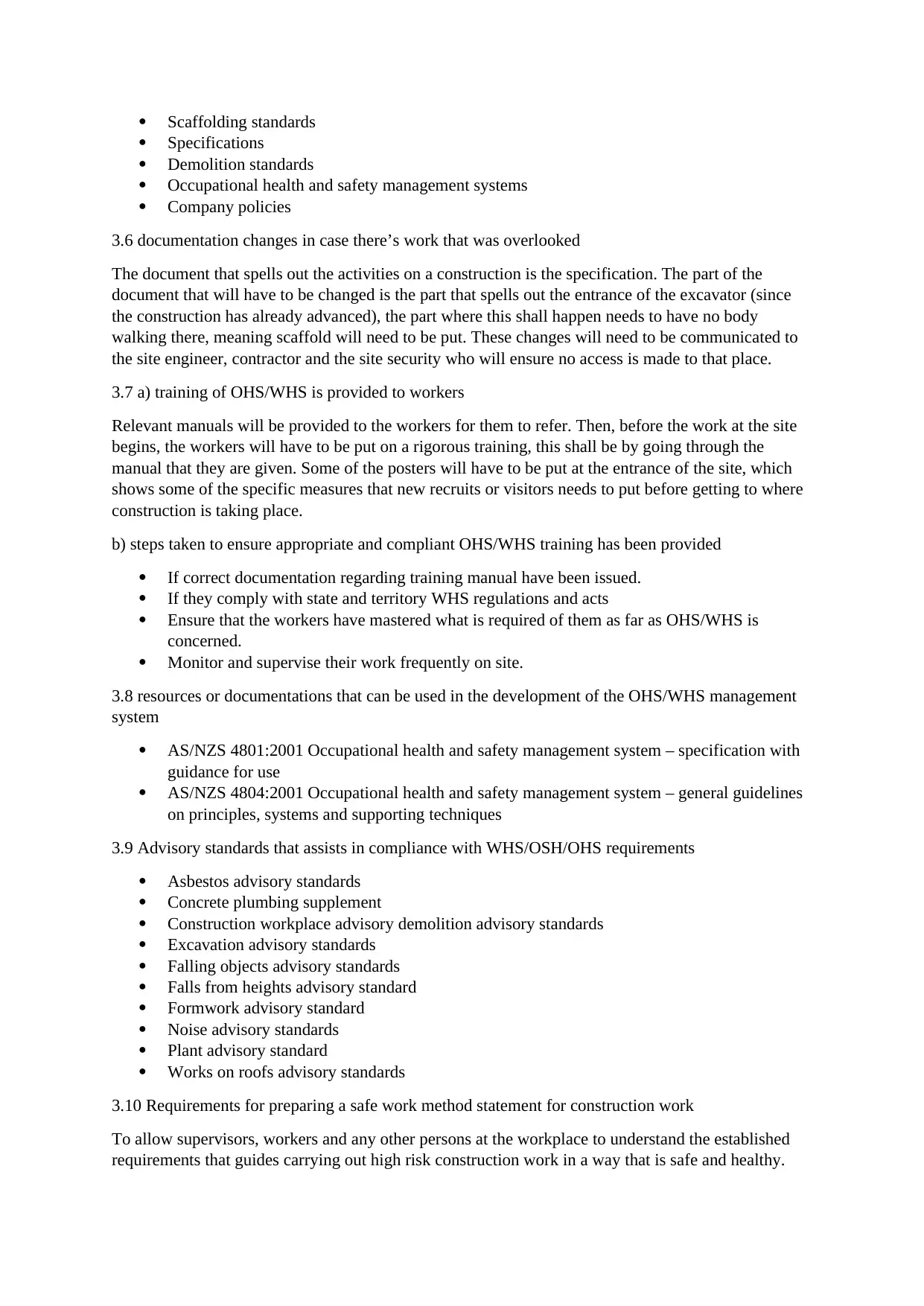
Scaffolding standards
Specifications
Demolition standards
Occupational health and safety management systems
Company policies
3.6 documentation changes in case there’s work that was overlooked
The document that spells out the activities on a construction is the specification. The part of the
document that will have to be changed is the part that spells out the entrance of the excavator (since
the construction has already advanced), the part where this shall happen needs to have no body
walking there, meaning scaffold will need to be put. These changes will need to be communicated to
the site engineer, contractor and the site security who will ensure no access is made to that place.
3.7 a) training of OHS/WHS is provided to workers
Relevant manuals will be provided to the workers for them to refer. Then, before the work at the site
begins, the workers will have to be put on a rigorous training, this shall be by going through the
manual that they are given. Some of the posters will have to be put at the entrance of the site, which
shows some of the specific measures that new recruits or visitors needs to put before getting to where
construction is taking place.
b) steps taken to ensure appropriate and compliant OHS/WHS training has been provided
If correct documentation regarding training manual have been issued.
If they comply with state and territory WHS regulations and acts
Ensure that the workers have mastered what is required of them as far as OHS/WHS is
concerned.
Monitor and supervise their work frequently on site.
3.8 resources or documentations that can be used in the development of the OHS/WHS management
system
AS/NZS 4801:2001 Occupational health and safety management system – specification with
guidance for use
AS/NZS 4804:2001 Occupational health and safety management system – general guidelines
on principles, systems and supporting techniques
3.9 Advisory standards that assists in compliance with WHS/OSH/OHS requirements
Asbestos advisory standards
Concrete plumbing supplement
Construction workplace advisory demolition advisory standards
Excavation advisory standards
Falling objects advisory standards
Falls from heights advisory standard
Formwork advisory standard
Noise advisory standards
Plant advisory standard
Works on roofs advisory standards
3.10 Requirements for preparing a safe work method statement for construction work
To allow supervisors, workers and any other persons at the workplace to understand the established
requirements that guides carrying out high risk construction work in a way that is safe and healthy.
Specifications
Demolition standards
Occupational health and safety management systems
Company policies
3.6 documentation changes in case there’s work that was overlooked
The document that spells out the activities on a construction is the specification. The part of the
document that will have to be changed is the part that spells out the entrance of the excavator (since
the construction has already advanced), the part where this shall happen needs to have no body
walking there, meaning scaffold will need to be put. These changes will need to be communicated to
the site engineer, contractor and the site security who will ensure no access is made to that place.
3.7 a) training of OHS/WHS is provided to workers
Relevant manuals will be provided to the workers for them to refer. Then, before the work at the site
begins, the workers will have to be put on a rigorous training, this shall be by going through the
manual that they are given. Some of the posters will have to be put at the entrance of the site, which
shows some of the specific measures that new recruits or visitors needs to put before getting to where
construction is taking place.
b) steps taken to ensure appropriate and compliant OHS/WHS training has been provided
If correct documentation regarding training manual have been issued.
If they comply with state and territory WHS regulations and acts
Ensure that the workers have mastered what is required of them as far as OHS/WHS is
concerned.
Monitor and supervise their work frequently on site.
3.8 resources or documentations that can be used in the development of the OHS/WHS management
system
AS/NZS 4801:2001 Occupational health and safety management system – specification with
guidance for use
AS/NZS 4804:2001 Occupational health and safety management system – general guidelines
on principles, systems and supporting techniques
3.9 Advisory standards that assists in compliance with WHS/OSH/OHS requirements
Asbestos advisory standards
Concrete plumbing supplement
Construction workplace advisory demolition advisory standards
Excavation advisory standards
Falling objects advisory standards
Falls from heights advisory standard
Formwork advisory standard
Noise advisory standards
Plant advisory standard
Works on roofs advisory standards
3.10 Requirements for preparing a safe work method statement for construction work
To allow supervisors, workers and any other persons at the workplace to understand the established
requirements that guides carrying out high risk construction work in a way that is safe and healthy.
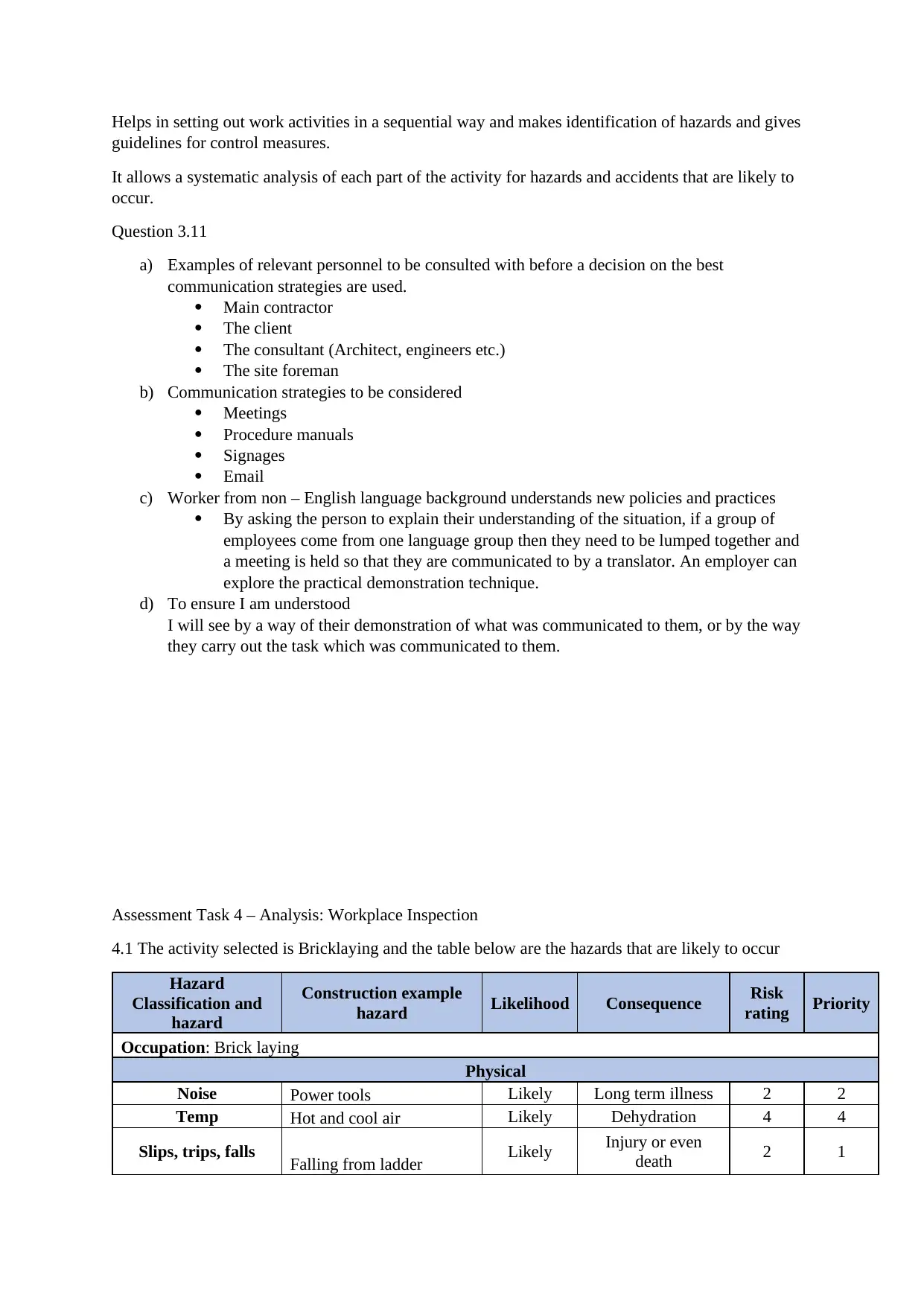
Helps in setting out work activities in a sequential way and makes identification of hazards and gives
guidelines for control measures.
It allows a systematic analysis of each part of the activity for hazards and accidents that are likely to
occur.
Question 3.11
a) Examples of relevant personnel to be consulted with before a decision on the best
communication strategies are used.
Main contractor
The client
The consultant (Architect, engineers etc.)
The site foreman
b) Communication strategies to be considered
Meetings
Procedure manuals
Signages
Email
c) Worker from non – English language background understands new policies and practices
By asking the person to explain their understanding of the situation, if a group of
employees come from one language group then they need to be lumped together and
a meeting is held so that they are communicated to by a translator. An employer can
explore the practical demonstration technique.
d) To ensure I am understood
I will see by a way of their demonstration of what was communicated to them, or by the way
they carry out the task which was communicated to them.
Assessment Task 4 – Analysis: Workplace Inspection
4.1 The activity selected is Bricklaying and the table below are the hazards that are likely to occur
Hazard
Classification and
hazard
Construction example
hazard Likelihood Consequence Risk
rating Priority
Occupation: Brick laying
Physical
Noise Power tools Likely Long term illness 2 2
Temp Hot and cool air Likely Dehydration 4 4
Slips, trips, falls Falling from ladder Likely Injury or even
death 2 1
guidelines for control measures.
It allows a systematic analysis of each part of the activity for hazards and accidents that are likely to
occur.
Question 3.11
a) Examples of relevant personnel to be consulted with before a decision on the best
communication strategies are used.
Main contractor
The client
The consultant (Architect, engineers etc.)
The site foreman
b) Communication strategies to be considered
Meetings
Procedure manuals
Signages
c) Worker from non – English language background understands new policies and practices
By asking the person to explain their understanding of the situation, if a group of
employees come from one language group then they need to be lumped together and
a meeting is held so that they are communicated to by a translator. An employer can
explore the practical demonstration technique.
d) To ensure I am understood
I will see by a way of their demonstration of what was communicated to them, or by the way
they carry out the task which was communicated to them.
Assessment Task 4 – Analysis: Workplace Inspection
4.1 The activity selected is Bricklaying and the table below are the hazards that are likely to occur
Hazard
Classification and
hazard
Construction example
hazard Likelihood Consequence Risk
rating Priority
Occupation: Brick laying
Physical
Noise Power tools Likely Long term illness 2 2
Temp Hot and cool air Likely Dehydration 4 4
Slips, trips, falls Falling from ladder Likely Injury or even
death 2 1
Secure Best Marks with AI Grader
Need help grading? Try our AI Grader for instant feedback on your assignments.
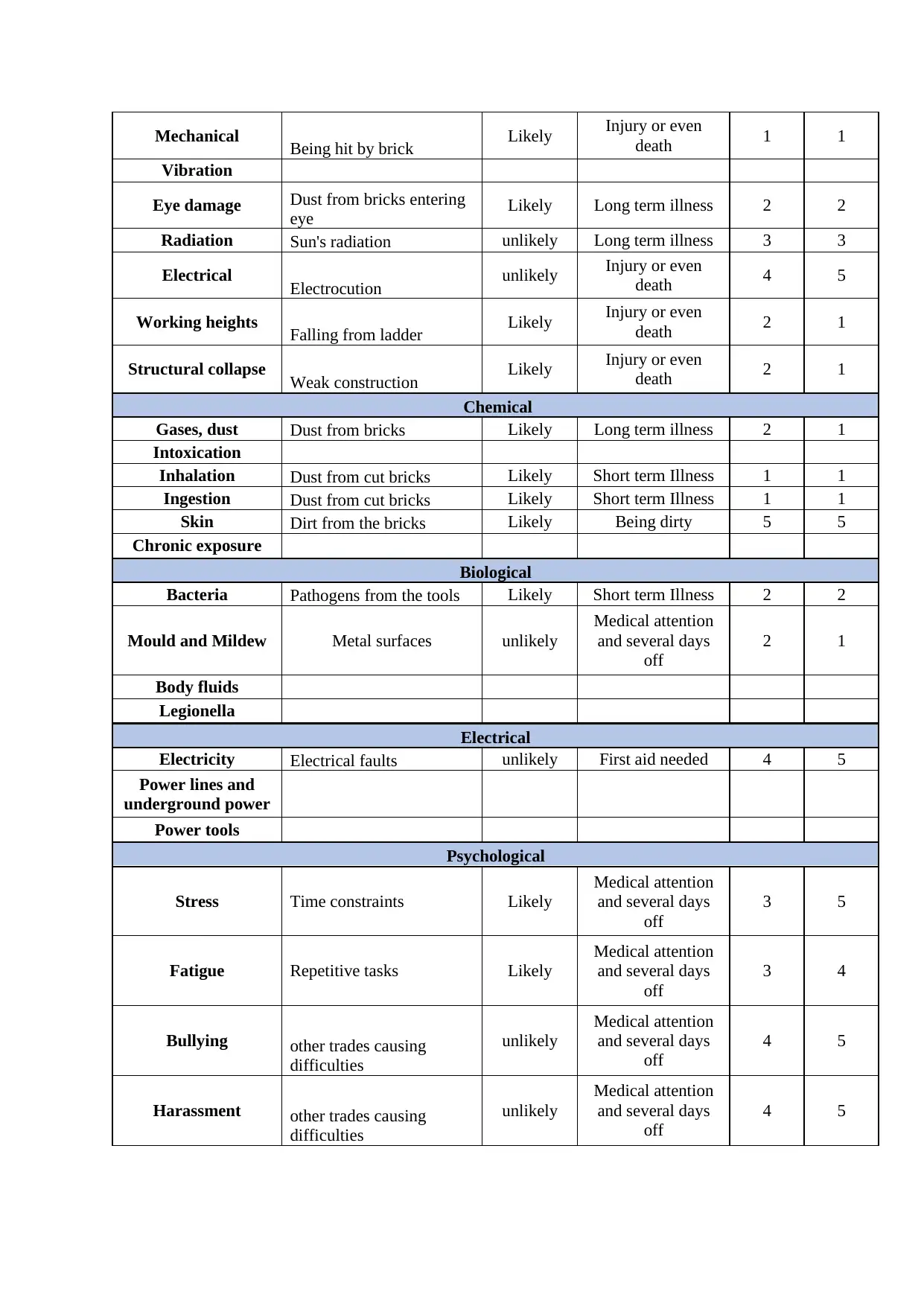
Mechanical Being hit by brick Likely Injury or even
death 1 1
Vibration
Eye damage Dust from bricks entering
eye Likely Long term illness 2 2
Radiation Sun's radiation unlikely Long term illness 3 3
Electrical Electrocution unlikely Injury or even
death 4 5
Working heights Falling from ladder Likely Injury or even
death 2 1
Structural collapse Weak construction Likely Injury or even
death 2 1
Chemical
Gases, dust Dust from bricks Likely Long term illness 2 1
Intoxication
Inhalation Dust from cut bricks Likely Short term Illness 1 1
Ingestion Dust from cut bricks Likely Short term Illness 1 1
Skin Dirt from the bricks Likely Being dirty 5 5
Chronic exposure
Biological
Bacteria Pathogens from the tools Likely Short term Illness 2 2
Mould and Mildew Metal surfaces unlikely
Medical attention
and several days
off
2 1
Body fluids
Legionella
Electrical
Electricity Electrical faults unlikely First aid needed 4 5
Power lines and
underground power
Power tools
Psychological
Stress Time constraints Likely
Medical attention
and several days
off
3 5
Fatigue Repetitive tasks Likely
Medical attention
and several days
off
3 4
Bullying other trades causing
difficulties
unlikely
Medical attention
and several days
off
4 5
Harassment other trades causing
difficulties
unlikely
Medical attention
and several days
off
4 5
death 1 1
Vibration
Eye damage Dust from bricks entering
eye Likely Long term illness 2 2
Radiation Sun's radiation unlikely Long term illness 3 3
Electrical Electrocution unlikely Injury or even
death 4 5
Working heights Falling from ladder Likely Injury or even
death 2 1
Structural collapse Weak construction Likely Injury or even
death 2 1
Chemical
Gases, dust Dust from bricks Likely Long term illness 2 1
Intoxication
Inhalation Dust from cut bricks Likely Short term Illness 1 1
Ingestion Dust from cut bricks Likely Short term Illness 1 1
Skin Dirt from the bricks Likely Being dirty 5 5
Chronic exposure
Biological
Bacteria Pathogens from the tools Likely Short term Illness 2 2
Mould and Mildew Metal surfaces unlikely
Medical attention
and several days
off
2 1
Body fluids
Legionella
Electrical
Electricity Electrical faults unlikely First aid needed 4 5
Power lines and
underground power
Power tools
Psychological
Stress Time constraints Likely
Medical attention
and several days
off
3 5
Fatigue Repetitive tasks Likely
Medical attention
and several days
off
3 4
Bullying other trades causing
difficulties
unlikely
Medical attention
and several days
off
4 5
Harassment other trades causing
difficulties
unlikely
Medical attention
and several days
off
4 5
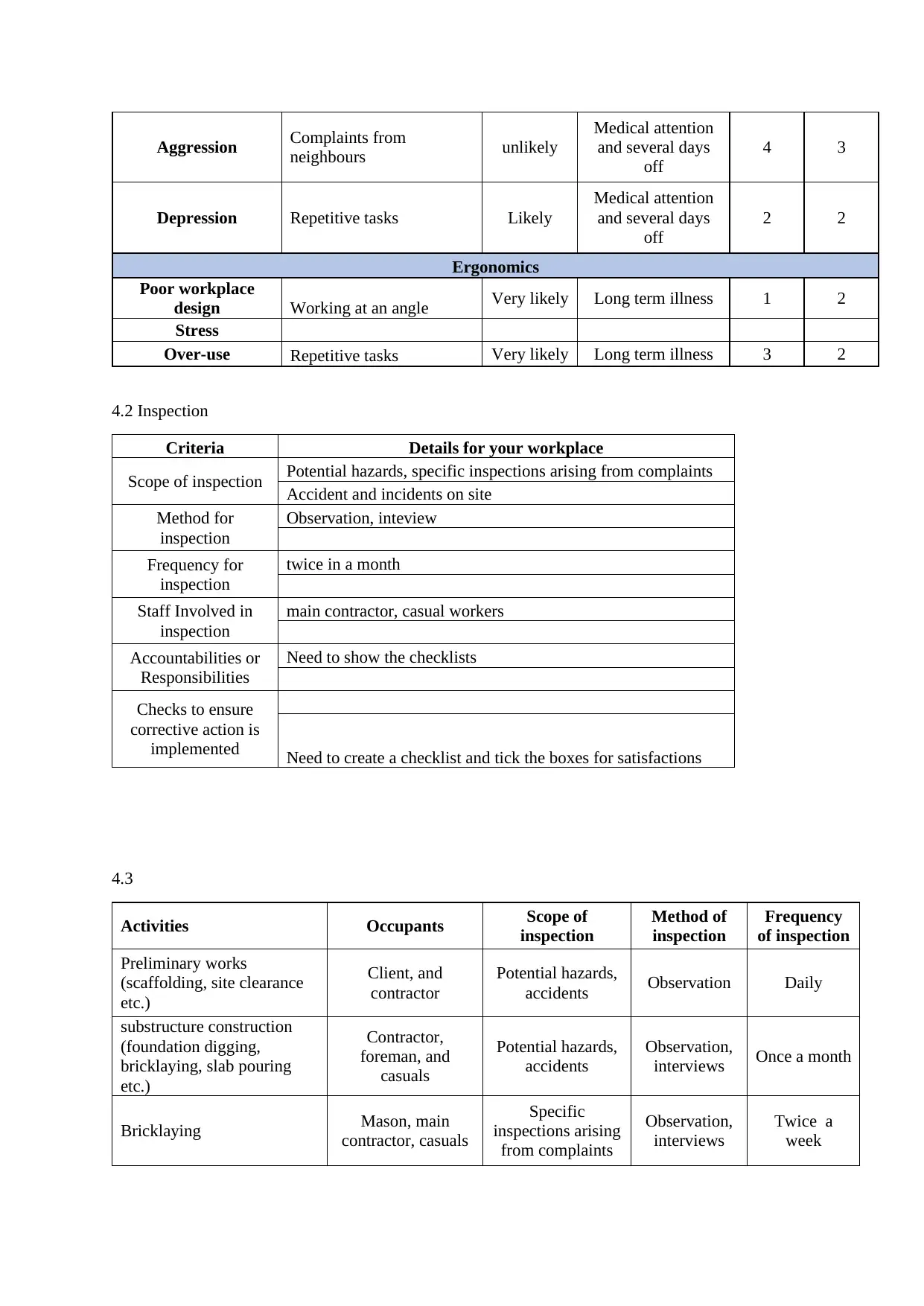
Aggression Complaints from
neighbours unlikely
Medical attention
and several days
off
4 3
Depression Repetitive tasks Likely
Medical attention
and several days
off
2 2
Ergonomics
Poor workplace
design Working at an angle Very likely Long term illness 1 2
Stress
Over-use Repetitive tasks Very likely Long term illness 3 2
4.2 Inspection
Criteria Details for your workplace
Scope of inspection Potential hazards, specific inspections arising from complaints
Accident and incidents on site
Method for
inspection
Observation, inteview
Frequency for
inspection
twice in a month
Staff Involved in
inspection
main contractor, casual workers
Accountabilities or
Responsibilities
Need to show the checklists
Checks to ensure
corrective action is
implemented Need to create a checklist and tick the boxes for satisfactions
4.3
Activities Occupants Scope of
inspection
Method of
inspection
Frequency
of inspection
Preliminary works
(scaffolding, site clearance
etc.)
Client, and
contractor
Potential hazards,
accidents Observation Daily
substructure construction
(foundation digging,
bricklaying, slab pouring
etc.)
Contractor,
foreman, and
casuals
Potential hazards,
accidents
Observation,
interviews Once a month
Bricklaying Mason, main
contractor, casuals
Specific
inspections arising
from complaints
Observation,
interviews
Twice a
week
neighbours unlikely
Medical attention
and several days
off
4 3
Depression Repetitive tasks Likely
Medical attention
and several days
off
2 2
Ergonomics
Poor workplace
design Working at an angle Very likely Long term illness 1 2
Stress
Over-use Repetitive tasks Very likely Long term illness 3 2
4.2 Inspection
Criteria Details for your workplace
Scope of inspection Potential hazards, specific inspections arising from complaints
Accident and incidents on site
Method for
inspection
Observation, inteview
Frequency for
inspection
twice in a month
Staff Involved in
inspection
main contractor, casual workers
Accountabilities or
Responsibilities
Need to show the checklists
Checks to ensure
corrective action is
implemented Need to create a checklist and tick the boxes for satisfactions
4.3
Activities Occupants Scope of
inspection
Method of
inspection
Frequency
of inspection
Preliminary works
(scaffolding, site clearance
etc.)
Client, and
contractor
Potential hazards,
accidents Observation Daily
substructure construction
(foundation digging,
bricklaying, slab pouring
etc.)
Contractor,
foreman, and
casuals
Potential hazards,
accidents
Observation,
interviews Once a month
Bricklaying Mason, main
contractor, casuals
Specific
inspections arising
from complaints
Observation,
interviews
Twice a
week
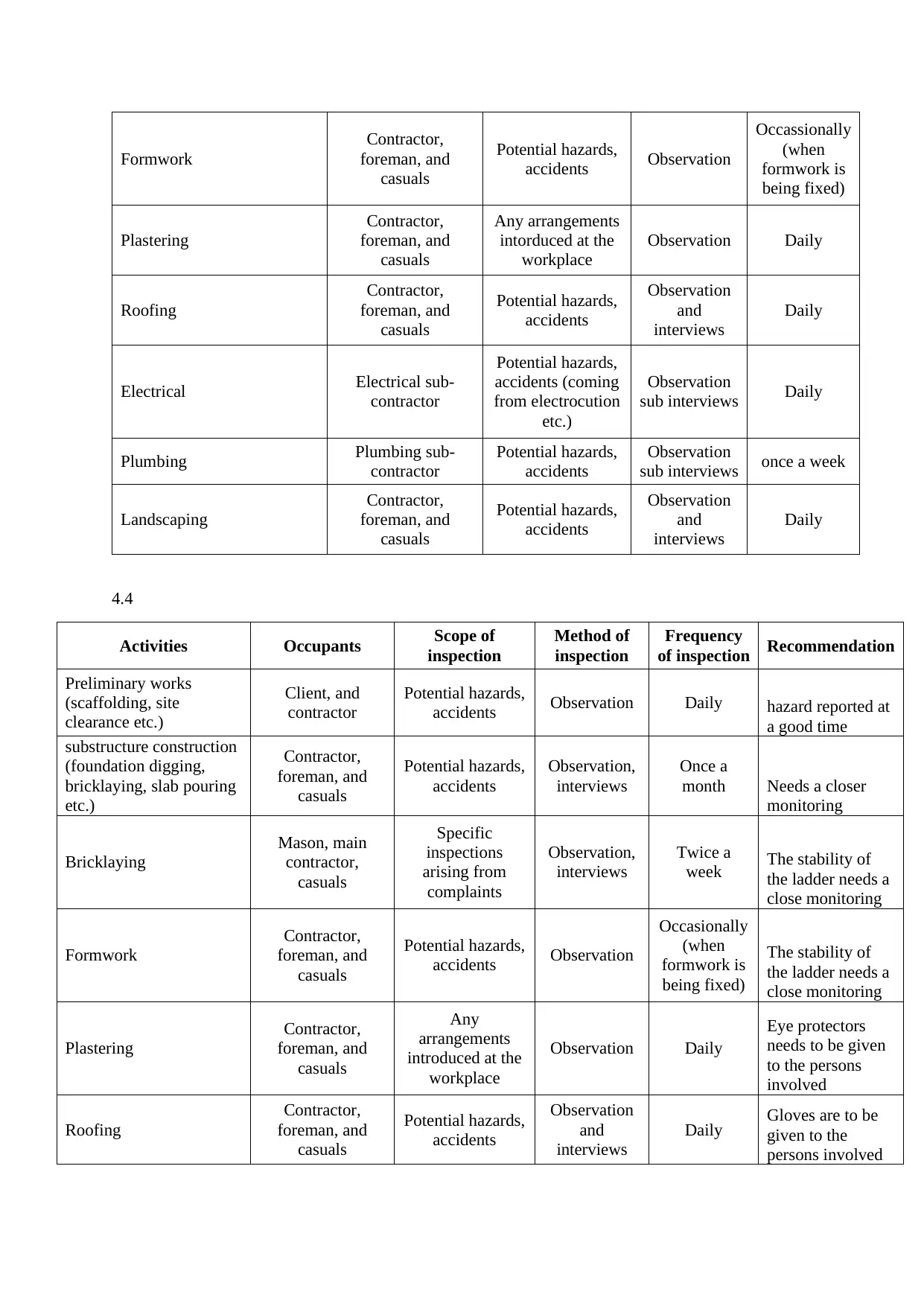
Formwork
Contractor,
foreman, and
casuals
Potential hazards,
accidents Observation
Occassionally
(when
formwork is
being fixed)
Plastering
Contractor,
foreman, and
casuals
Any arrangements
intorduced at the
workplace
Observation Daily
Roofing
Contractor,
foreman, and
casuals
Potential hazards,
accidents
Observation
and
interviews
Daily
Electrical Electrical sub-
contractor
Potential hazards,
accidents (coming
from electrocution
etc.)
Observation
sub interviews Daily
Plumbing Plumbing sub-
contractor
Potential hazards,
accidents
Observation
sub interviews once a week
Landscaping
Contractor,
foreman, and
casuals
Potential hazards,
accidents
Observation
and
interviews
Daily
4.4
Activities Occupants Scope of
inspection
Method of
inspection
Frequency
of inspection Recommendation
Preliminary works
(scaffolding, site
clearance etc.)
Client, and
contractor
Potential hazards,
accidents Observation Daily hazard reported at
a good time
substructure construction
(foundation digging,
bricklaying, slab pouring
etc.)
Contractor,
foreman, and
casuals
Potential hazards,
accidents
Observation,
interviews
Once a
month Needs a closer
monitoring
Bricklaying
Mason, main
contractor,
casuals
Specific
inspections
arising from
complaints
Observation,
interviews
Twice a
week The stability of
the ladder needs a
close monitoring
Formwork
Contractor,
foreman, and
casuals
Potential hazards,
accidents Observation
Occasionally
(when
formwork is
being fixed)
The stability of
the ladder needs a
close monitoring
Plastering
Contractor,
foreman, and
casuals
Any
arrangements
introduced at the
workplace
Observation Daily
Eye protectors
needs to be given
to the persons
involved
Roofing
Contractor,
foreman, and
casuals
Potential hazards,
accidents
Observation
and
interviews
Daily Gloves are to be
given to the
persons involved
Contractor,
foreman, and
casuals
Potential hazards,
accidents Observation
Occassionally
(when
formwork is
being fixed)
Plastering
Contractor,
foreman, and
casuals
Any arrangements
intorduced at the
workplace
Observation Daily
Roofing
Contractor,
foreman, and
casuals
Potential hazards,
accidents
Observation
and
interviews
Daily
Electrical Electrical sub-
contractor
Potential hazards,
accidents (coming
from electrocution
etc.)
Observation
sub interviews Daily
Plumbing Plumbing sub-
contractor
Potential hazards,
accidents
Observation
sub interviews once a week
Landscaping
Contractor,
foreman, and
casuals
Potential hazards,
accidents
Observation
and
interviews
Daily
4.4
Activities Occupants Scope of
inspection
Method of
inspection
Frequency
of inspection Recommendation
Preliminary works
(scaffolding, site
clearance etc.)
Client, and
contractor
Potential hazards,
accidents Observation Daily hazard reported at
a good time
substructure construction
(foundation digging,
bricklaying, slab pouring
etc.)
Contractor,
foreman, and
casuals
Potential hazards,
accidents
Observation,
interviews
Once a
month Needs a closer
monitoring
Bricklaying
Mason, main
contractor,
casuals
Specific
inspections
arising from
complaints
Observation,
interviews
Twice a
week The stability of
the ladder needs a
close monitoring
Formwork
Contractor,
foreman, and
casuals
Potential hazards,
accidents Observation
Occasionally
(when
formwork is
being fixed)
The stability of
the ladder needs a
close monitoring
Plastering
Contractor,
foreman, and
casuals
Any
arrangements
introduced at the
workplace
Observation Daily
Eye protectors
needs to be given
to the persons
involved
Roofing
Contractor,
foreman, and
casuals
Potential hazards,
accidents
Observation
and
interviews
Daily Gloves are to be
given to the
persons involved
Paraphrase This Document
Need a fresh take? Get an instant paraphrase of this document with our AI Paraphraser
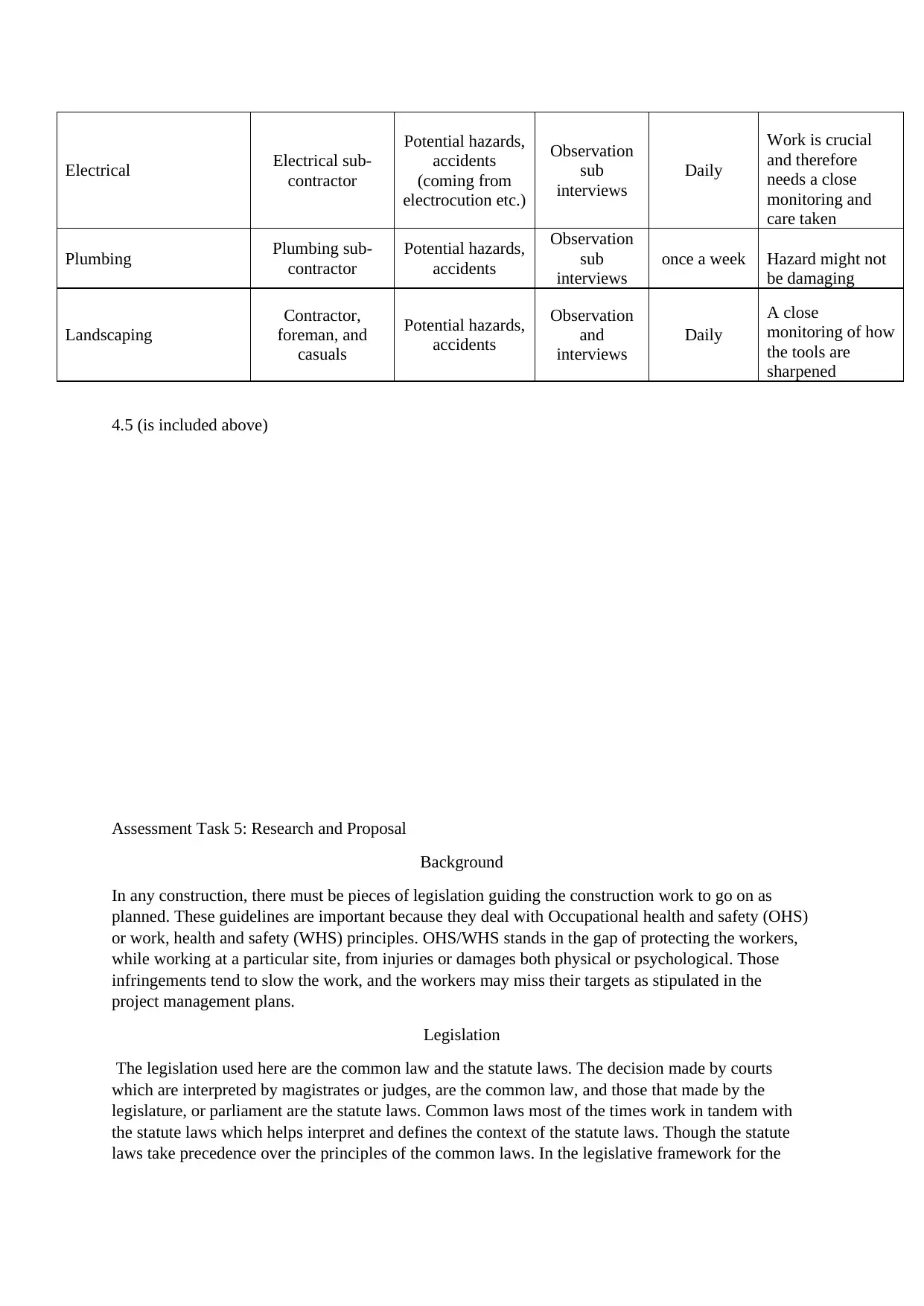
Electrical Electrical sub-
contractor
Potential hazards,
accidents
(coming from
electrocution etc.)
Observation
sub
interviews
Daily
Work is crucial
and therefore
needs a close
monitoring and
care taken
Plumbing Plumbing sub-
contractor
Potential hazards,
accidents
Observation
sub
interviews
once a week Hazard might not
be damaging
Landscaping
Contractor,
foreman, and
casuals
Potential hazards,
accidents
Observation
and
interviews
Daily
A close
monitoring of how
the tools are
sharpened
4.5 (is included above)
Assessment Task 5: Research and Proposal
Background
In any construction, there must be pieces of legislation guiding the construction work to go on as
planned. These guidelines are important because they deal with Occupational health and safety (OHS)
or work, health and safety (WHS) principles. OHS/WHS stands in the gap of protecting the workers,
while working at a particular site, from injuries or damages both physical or psychological. Those
infringements tend to slow the work, and the workers may miss their targets as stipulated in the
project management plans.
Legislation
The legislation used here are the common law and the statute laws. The decision made by courts
which are interpreted by magistrates or judges, are the common law, and those that made by the
legislature, or parliament are the statute laws. Common laws most of the times work in tandem with
the statute laws which helps interpret and defines the context of the statute laws. Though the statute
laws take precedence over the principles of the common laws. In the legislative framework for the
contractor
Potential hazards,
accidents
(coming from
electrocution etc.)
Observation
sub
interviews
Daily
Work is crucial
and therefore
needs a close
monitoring and
care taken
Plumbing Plumbing sub-
contractor
Potential hazards,
accidents
Observation
sub
interviews
once a week Hazard might not
be damaging
Landscaping
Contractor,
foreman, and
casuals
Potential hazards,
accidents
Observation
and
interviews
Daily
A close
monitoring of how
the tools are
sharpened
4.5 (is included above)
Assessment Task 5: Research and Proposal
Background
In any construction, there must be pieces of legislation guiding the construction work to go on as
planned. These guidelines are important because they deal with Occupational health and safety (OHS)
or work, health and safety (WHS) principles. OHS/WHS stands in the gap of protecting the workers,
while working at a particular site, from injuries or damages both physical or psychological. Those
infringements tend to slow the work, and the workers may miss their targets as stipulated in the
project management plans.
Legislation
The legislation used here are the common law and the statute laws. The decision made by courts
which are interpreted by magistrates or judges, are the common law, and those that made by the
legislature, or parliament are the statute laws. Common laws most of the times work in tandem with
the statute laws which helps interpret and defines the context of the statute laws. Though the statute
laws take precedence over the principles of the common laws. In the legislative framework for the
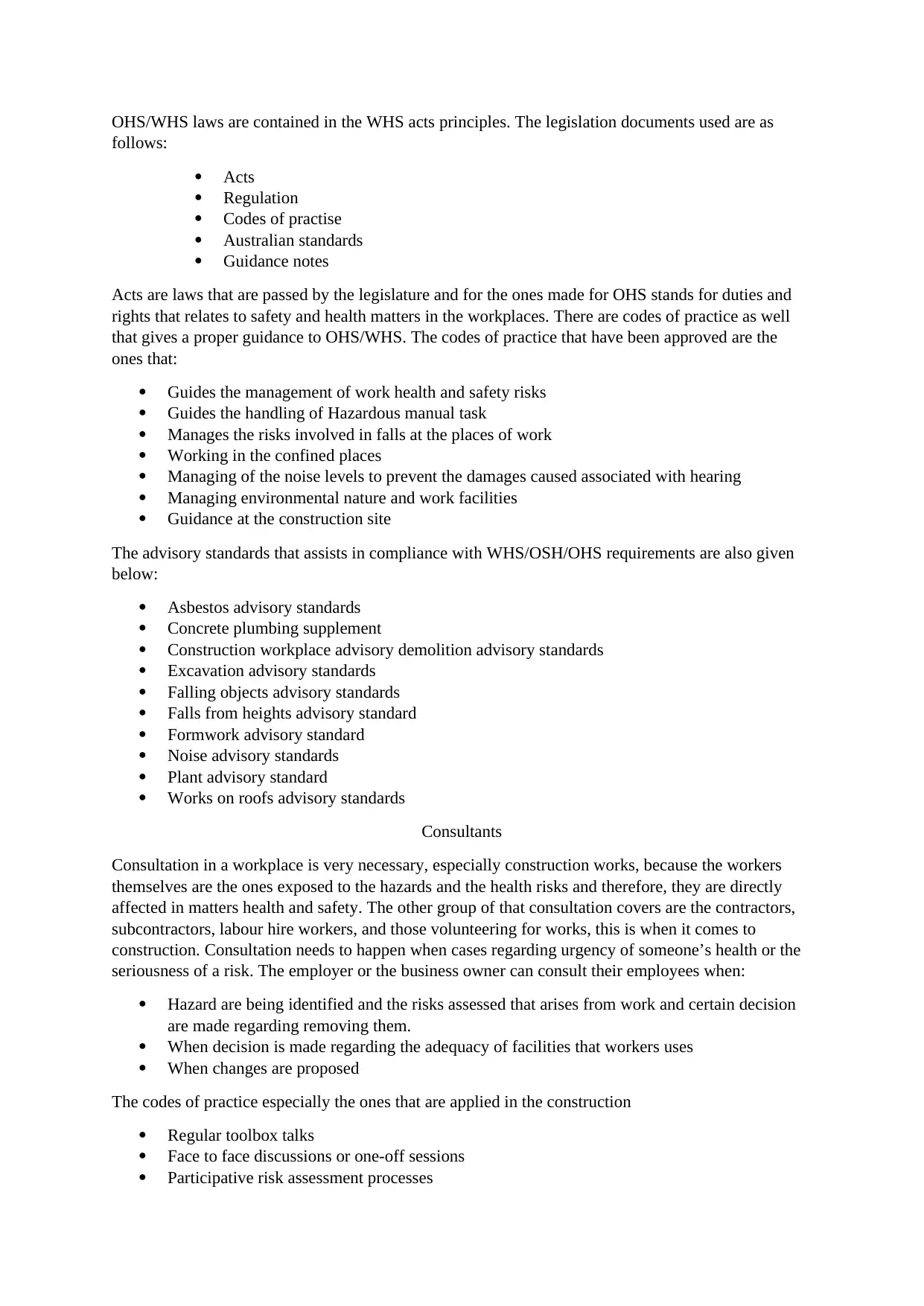
OHS/WHS laws are contained in the WHS acts principles. The legislation documents used are as
follows:
Acts
Regulation
Codes of practise
Australian standards
Guidance notes
Acts are laws that are passed by the legislature and for the ones made for OHS stands for duties and
rights that relates to safety and health matters in the workplaces. There are codes of practice as well
that gives a proper guidance to OHS/WHS. The codes of practice that have been approved are the
ones that:
Guides the management of work health and safety risks
Guides the handling of Hazardous manual task
Manages the risks involved in falls at the places of work
Working in the confined places
Managing of the noise levels to prevent the damages caused associated with hearing
Managing environmental nature and work facilities
Guidance at the construction site
The advisory standards that assists in compliance with WHS/OSH/OHS requirements are also given
below:
Asbestos advisory standards
Concrete plumbing supplement
Construction workplace advisory demolition advisory standards
Excavation advisory standards
Falling objects advisory standards
Falls from heights advisory standard
Formwork advisory standard
Noise advisory standards
Plant advisory standard
Works on roofs advisory standards
Consultants
Consultation in a workplace is very necessary, especially construction works, because the workers
themselves are the ones exposed to the hazards and the health risks and therefore, they are directly
affected in matters health and safety. The other group of that consultation covers are the contractors,
subcontractors, labour hire workers, and those volunteering for works, this is when it comes to
construction. Consultation needs to happen when cases regarding urgency of someone’s health or the
seriousness of a risk. The employer or the business owner can consult their employees when:
Hazard are being identified and the risks assessed that arises from work and certain decision
are made regarding removing them.
When decision is made regarding the adequacy of facilities that workers uses
When changes are proposed
The codes of practice especially the ones that are applied in the construction
Regular toolbox talks
Face to face discussions or one-off sessions
Participative risk assessment processes
follows:
Acts
Regulation
Codes of practise
Australian standards
Guidance notes
Acts are laws that are passed by the legislature and for the ones made for OHS stands for duties and
rights that relates to safety and health matters in the workplaces. There are codes of practice as well
that gives a proper guidance to OHS/WHS. The codes of practice that have been approved are the
ones that:
Guides the management of work health and safety risks
Guides the handling of Hazardous manual task
Manages the risks involved in falls at the places of work
Working in the confined places
Managing of the noise levels to prevent the damages caused associated with hearing
Managing environmental nature and work facilities
Guidance at the construction site
The advisory standards that assists in compliance with WHS/OSH/OHS requirements are also given
below:
Asbestos advisory standards
Concrete plumbing supplement
Construction workplace advisory demolition advisory standards
Excavation advisory standards
Falling objects advisory standards
Falls from heights advisory standard
Formwork advisory standard
Noise advisory standards
Plant advisory standard
Works on roofs advisory standards
Consultants
Consultation in a workplace is very necessary, especially construction works, because the workers
themselves are the ones exposed to the hazards and the health risks and therefore, they are directly
affected in matters health and safety. The other group of that consultation covers are the contractors,
subcontractors, labour hire workers, and those volunteering for works, this is when it comes to
construction. Consultation needs to happen when cases regarding urgency of someone’s health or the
seriousness of a risk. The employer or the business owner can consult their employees when:
Hazard are being identified and the risks assessed that arises from work and certain decision
are made regarding removing them.
When decision is made regarding the adequacy of facilities that workers uses
When changes are proposed
The codes of practice especially the ones that are applied in the construction
Regular toolbox talks
Face to face discussions or one-off sessions
Participative risk assessment processes
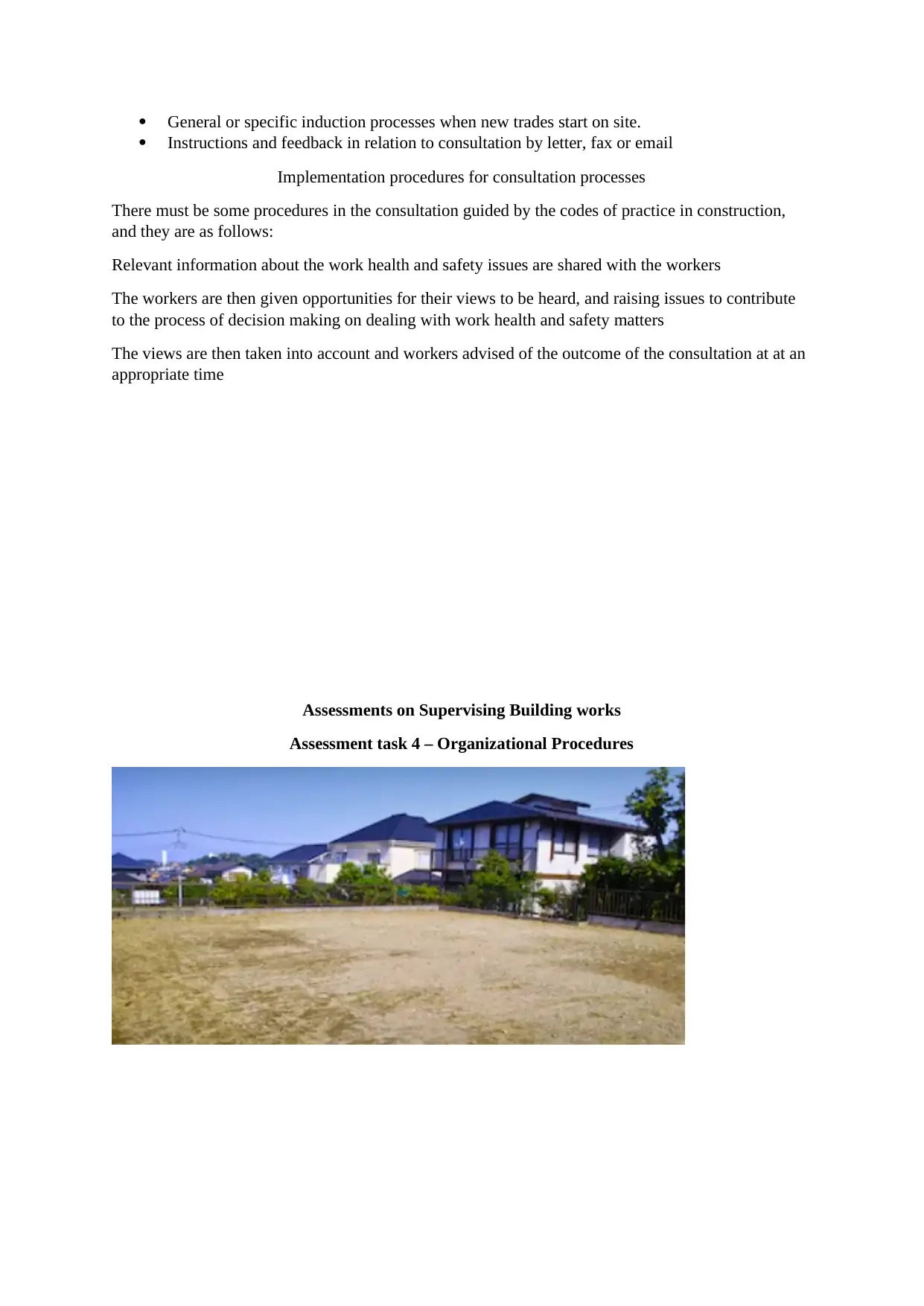
General or specific induction processes when new trades start on site.
Instructions and feedback in relation to consultation by letter, fax or email
Implementation procedures for consultation processes
There must be some procedures in the consultation guided by the codes of practice in construction,
and they are as follows:
Relevant information about the work health and safety issues are shared with the workers
The workers are then given opportunities for their views to be heard, and raising issues to contribute
to the process of decision making on dealing with work health and safety matters
The views are then taken into account and workers advised of the outcome of the consultation at at an
appropriate time
Assessments on Supervising Building works
Assessment task 4 – Organizational Procedures
Instructions and feedback in relation to consultation by letter, fax or email
Implementation procedures for consultation processes
There must be some procedures in the consultation guided by the codes of practice in construction,
and they are as follows:
Relevant information about the work health and safety issues are shared with the workers
The workers are then given opportunities for their views to be heard, and raising issues to contribute
to the process of decision making on dealing with work health and safety matters
The views are then taken into account and workers advised of the outcome of the consultation at at an
appropriate time
Assessments on Supervising Building works
Assessment task 4 – Organizational Procedures
Secure Best Marks with AI Grader
Need help grading? Try our AI Grader for instant feedback on your assignments.
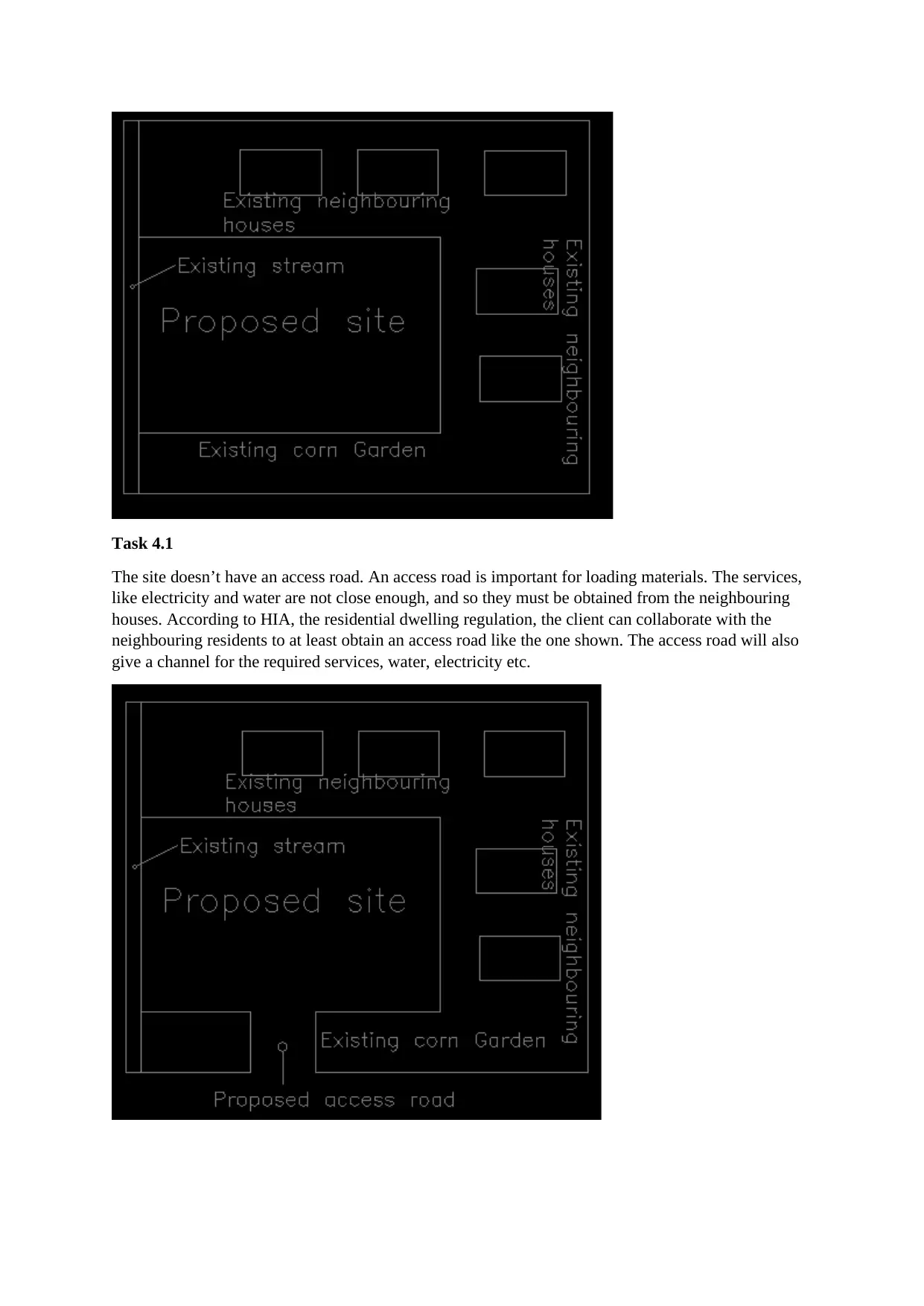
Task 4.1
The site doesn’t have an access road. An access road is important for loading materials. The services,
like electricity and water are not close enough, and so they must be obtained from the neighbouring
houses. According to HIA, the residential dwelling regulation, the client can collaborate with the
neighbouring residents to at least obtain an access road like the one shown. The access road will also
give a channel for the required services, water, electricity etc.
The site doesn’t have an access road. An access road is important for loading materials. The services,
like electricity and water are not close enough, and so they must be obtained from the neighbouring
houses. According to HIA, the residential dwelling regulation, the client can collaborate with the
neighbouring residents to at least obtain an access road like the one shown. The access road will also
give a channel for the required services, water, electricity etc.
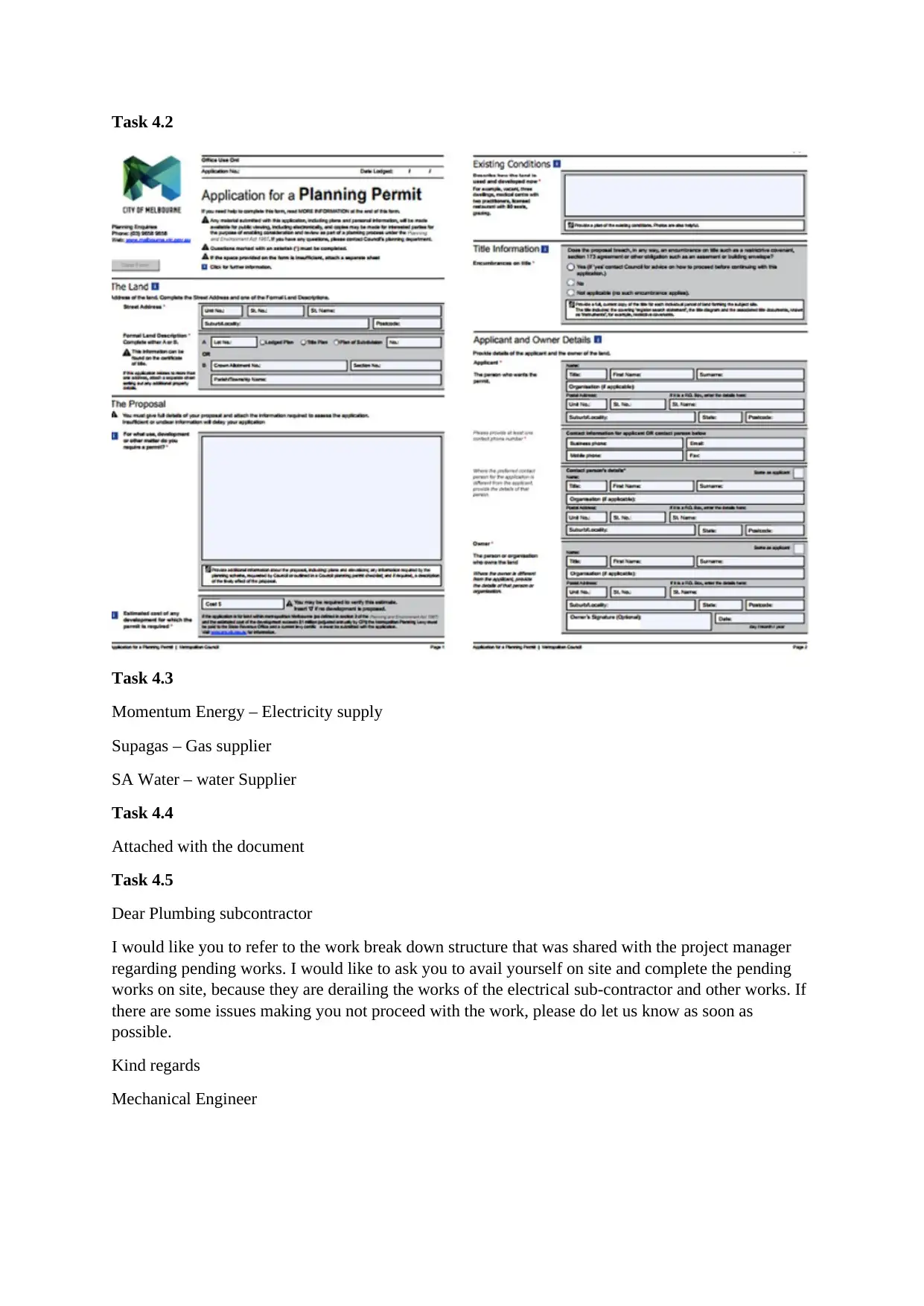
Task 4.2
Task 4.3
Momentum Energy – Electricity supply
Supagas – Gas supplier
SA Water – water Supplier
Task 4.4
Attached with the document
Task 4.5
Dear Plumbing subcontractor
I would like you to refer to the work break down structure that was shared with the project manager
regarding pending works. I would like to ask you to avail yourself on site and complete the pending
works on site, because they are derailing the works of the electrical sub-contractor and other works. If
there are some issues making you not proceed with the work, please do let us know as soon as
possible.
Kind regards
Mechanical Engineer
Task 4.3
Momentum Energy – Electricity supply
Supagas – Gas supplier
SA Water – water Supplier
Task 4.4
Attached with the document
Task 4.5
Dear Plumbing subcontractor
I would like you to refer to the work break down structure that was shared with the project manager
regarding pending works. I would like to ask you to avail yourself on site and complete the pending
works on site, because they are derailing the works of the electrical sub-contractor and other works. If
there are some issues making you not proceed with the work, please do let us know as soon as
possible.
Kind regards
Mechanical Engineer
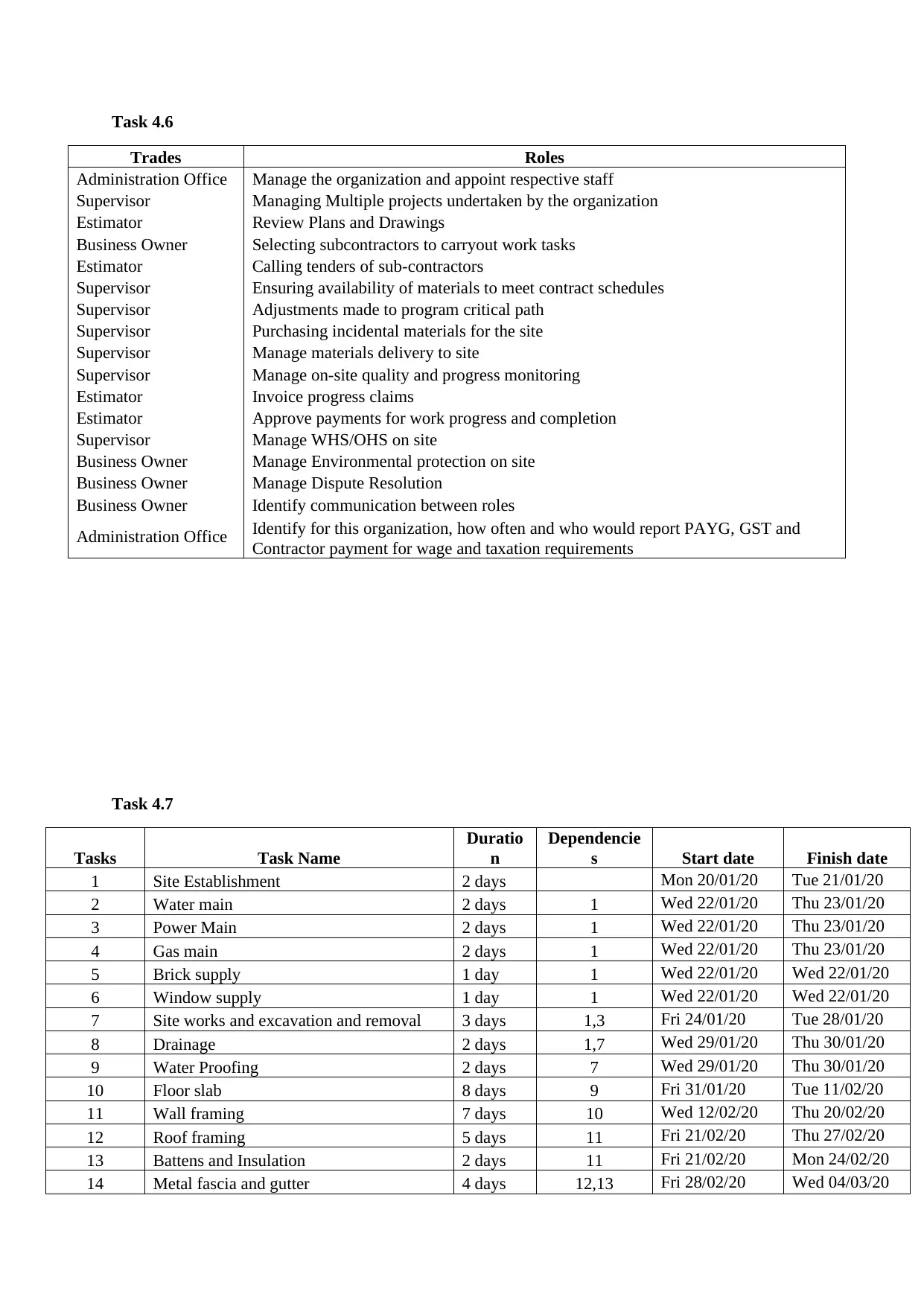
Task 4.6
Trades Roles
Administration Office Manage the organization and appoint respective staff
Supervisor Managing Multiple projects undertaken by the organization
Estimator Review Plans and Drawings
Business Owner Selecting subcontractors to carryout work tasks
Estimator Calling tenders of sub-contractors
Supervisor Ensuring availability of materials to meet contract schedules
Supervisor Adjustments made to program critical path
Supervisor Purchasing incidental materials for the site
Supervisor Manage materials delivery to site
Supervisor Manage on-site quality and progress monitoring
Estimator Invoice progress claims
Estimator Approve payments for work progress and completion
Supervisor Manage WHS/OHS on site
Business Owner Manage Environmental protection on site
Business Owner Manage Dispute Resolution
Business Owner Identify communication between roles
Administration Office Identify for this organization, how often and who would report PAYG, GST and
Contractor payment for wage and taxation requirements
Task 4.7
Tasks Task Name
Duratio
n
Dependencie
s Start date Finish date
1 Site Establishment 2 days Mon 20/01/20 Tue 21/01/20
2 Water main 2 days 1 Wed 22/01/20 Thu 23/01/20
3 Power Main 2 days 1 Wed 22/01/20 Thu 23/01/20
4 Gas main 2 days 1 Wed 22/01/20 Thu 23/01/20
5 Brick supply 1 day 1 Wed 22/01/20 Wed 22/01/20
6 Window supply 1 day 1 Wed 22/01/20 Wed 22/01/20
7 Site works and excavation and removal 3 days 1,3 Fri 24/01/20 Tue 28/01/20
8 Drainage 2 days 1,7 Wed 29/01/20 Thu 30/01/20
9 Water Proofing 2 days 7 Wed 29/01/20 Thu 30/01/20
10 Floor slab 8 days 9 Fri 31/01/20 Tue 11/02/20
11 Wall framing 7 days 10 Wed 12/02/20 Thu 20/02/20
12 Roof framing 5 days 11 Fri 21/02/20 Thu 27/02/20
13 Battens and Insulation 2 days 11 Fri 21/02/20 Mon 24/02/20
14 Metal fascia and gutter 4 days 12,13 Fri 28/02/20 Wed 04/03/20
Trades Roles
Administration Office Manage the organization and appoint respective staff
Supervisor Managing Multiple projects undertaken by the organization
Estimator Review Plans and Drawings
Business Owner Selecting subcontractors to carryout work tasks
Estimator Calling tenders of sub-contractors
Supervisor Ensuring availability of materials to meet contract schedules
Supervisor Adjustments made to program critical path
Supervisor Purchasing incidental materials for the site
Supervisor Manage materials delivery to site
Supervisor Manage on-site quality and progress monitoring
Estimator Invoice progress claims
Estimator Approve payments for work progress and completion
Supervisor Manage WHS/OHS on site
Business Owner Manage Environmental protection on site
Business Owner Manage Dispute Resolution
Business Owner Identify communication between roles
Administration Office Identify for this organization, how often and who would report PAYG, GST and
Contractor payment for wage and taxation requirements
Task 4.7
Tasks Task Name
Duratio
n
Dependencie
s Start date Finish date
1 Site Establishment 2 days Mon 20/01/20 Tue 21/01/20
2 Water main 2 days 1 Wed 22/01/20 Thu 23/01/20
3 Power Main 2 days 1 Wed 22/01/20 Thu 23/01/20
4 Gas main 2 days 1 Wed 22/01/20 Thu 23/01/20
5 Brick supply 1 day 1 Wed 22/01/20 Wed 22/01/20
6 Window supply 1 day 1 Wed 22/01/20 Wed 22/01/20
7 Site works and excavation and removal 3 days 1,3 Fri 24/01/20 Tue 28/01/20
8 Drainage 2 days 1,7 Wed 29/01/20 Thu 30/01/20
9 Water Proofing 2 days 7 Wed 29/01/20 Thu 30/01/20
10 Floor slab 8 days 9 Fri 31/01/20 Tue 11/02/20
11 Wall framing 7 days 10 Wed 12/02/20 Thu 20/02/20
12 Roof framing 5 days 11 Fri 21/02/20 Thu 27/02/20
13 Battens and Insulation 2 days 11 Fri 21/02/20 Mon 24/02/20
14 Metal fascia and gutter 4 days 12,13 Fri 28/02/20 Wed 04/03/20
Paraphrase This Document
Need a fresh take? Get an instant paraphrase of this document with our AI Paraphraser
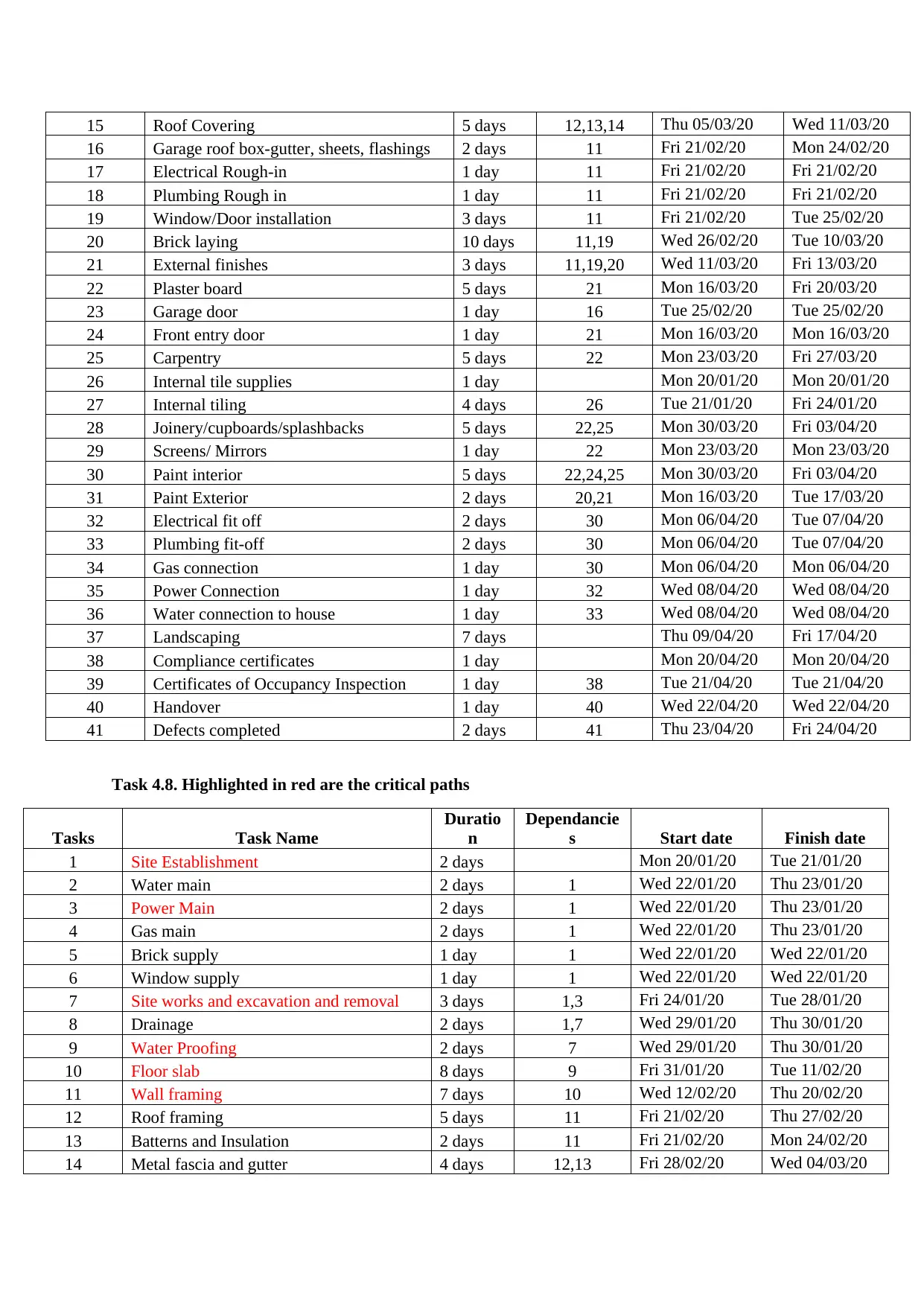
15 Roof Covering 5 days 12,13,14 Thu 05/03/20 Wed 11/03/20
16 Garage roof box-gutter, sheets, flashings 2 days 11 Fri 21/02/20 Mon 24/02/20
17 Electrical Rough-in 1 day 11 Fri 21/02/20 Fri 21/02/20
18 Plumbing Rough in 1 day 11 Fri 21/02/20 Fri 21/02/20
19 Window/Door installation 3 days 11 Fri 21/02/20 Tue 25/02/20
20 Brick laying 10 days 11,19 Wed 26/02/20 Tue 10/03/20
21 External finishes 3 days 11,19,20 Wed 11/03/20 Fri 13/03/20
22 Plaster board 5 days 21 Mon 16/03/20 Fri 20/03/20
23 Garage door 1 day 16 Tue 25/02/20 Tue 25/02/20
24 Front entry door 1 day 21 Mon 16/03/20 Mon 16/03/20
25 Carpentry 5 days 22 Mon 23/03/20 Fri 27/03/20
26 Internal tile supplies 1 day Mon 20/01/20 Mon 20/01/20
27 Internal tiling 4 days 26 Tue 21/01/20 Fri 24/01/20
28 Joinery/cupboards/splashbacks 5 days 22,25 Mon 30/03/20 Fri 03/04/20
29 Screens/ Mirrors 1 day 22 Mon 23/03/20 Mon 23/03/20
30 Paint interior 5 days 22,24,25 Mon 30/03/20 Fri 03/04/20
31 Paint Exterior 2 days 20,21 Mon 16/03/20 Tue 17/03/20
32 Electrical fit off 2 days 30 Mon 06/04/20 Tue 07/04/20
33 Plumbing fit-off 2 days 30 Mon 06/04/20 Tue 07/04/20
34 Gas connection 1 day 30 Mon 06/04/20 Mon 06/04/20
35 Power Connection 1 day 32 Wed 08/04/20 Wed 08/04/20
36 Water connection to house 1 day 33 Wed 08/04/20 Wed 08/04/20
37 Landscaping 7 days Thu 09/04/20 Fri 17/04/20
38 Compliance certificates 1 day Mon 20/04/20 Mon 20/04/20
39 Certificates of Occupancy Inspection 1 day 38 Tue 21/04/20 Tue 21/04/20
40 Handover 1 day 40 Wed 22/04/20 Wed 22/04/20
41 Defects completed 2 days 41 Thu 23/04/20 Fri 24/04/20
Task 4.8. Highlighted in red are the critical paths
Tasks Task Name
Duratio
n
Dependancie
s Start date Finish date
1 Site Establishment 2 days Mon 20/01/20 Tue 21/01/20
2 Water main 2 days 1 Wed 22/01/20 Thu 23/01/20
3 Power Main 2 days 1 Wed 22/01/20 Thu 23/01/20
4 Gas main 2 days 1 Wed 22/01/20 Thu 23/01/20
5 Brick supply 1 day 1 Wed 22/01/20 Wed 22/01/20
6 Window supply 1 day 1 Wed 22/01/20 Wed 22/01/20
7 Site works and excavation and removal 3 days 1,3 Fri 24/01/20 Tue 28/01/20
8 Drainage 2 days 1,7 Wed 29/01/20 Thu 30/01/20
9 Water Proofing 2 days 7 Wed 29/01/20 Thu 30/01/20
10 Floor slab 8 days 9 Fri 31/01/20 Tue 11/02/20
11 Wall framing 7 days 10 Wed 12/02/20 Thu 20/02/20
12 Roof framing 5 days 11 Fri 21/02/20 Thu 27/02/20
13 Batterns and Insulation 2 days 11 Fri 21/02/20 Mon 24/02/20
14 Metal fascia and gutter 4 days 12,13 Fri 28/02/20 Wed 04/03/20
16 Garage roof box-gutter, sheets, flashings 2 days 11 Fri 21/02/20 Mon 24/02/20
17 Electrical Rough-in 1 day 11 Fri 21/02/20 Fri 21/02/20
18 Plumbing Rough in 1 day 11 Fri 21/02/20 Fri 21/02/20
19 Window/Door installation 3 days 11 Fri 21/02/20 Tue 25/02/20
20 Brick laying 10 days 11,19 Wed 26/02/20 Tue 10/03/20
21 External finishes 3 days 11,19,20 Wed 11/03/20 Fri 13/03/20
22 Plaster board 5 days 21 Mon 16/03/20 Fri 20/03/20
23 Garage door 1 day 16 Tue 25/02/20 Tue 25/02/20
24 Front entry door 1 day 21 Mon 16/03/20 Mon 16/03/20
25 Carpentry 5 days 22 Mon 23/03/20 Fri 27/03/20
26 Internal tile supplies 1 day Mon 20/01/20 Mon 20/01/20
27 Internal tiling 4 days 26 Tue 21/01/20 Fri 24/01/20
28 Joinery/cupboards/splashbacks 5 days 22,25 Mon 30/03/20 Fri 03/04/20
29 Screens/ Mirrors 1 day 22 Mon 23/03/20 Mon 23/03/20
30 Paint interior 5 days 22,24,25 Mon 30/03/20 Fri 03/04/20
31 Paint Exterior 2 days 20,21 Mon 16/03/20 Tue 17/03/20
32 Electrical fit off 2 days 30 Mon 06/04/20 Tue 07/04/20
33 Plumbing fit-off 2 days 30 Mon 06/04/20 Tue 07/04/20
34 Gas connection 1 day 30 Mon 06/04/20 Mon 06/04/20
35 Power Connection 1 day 32 Wed 08/04/20 Wed 08/04/20
36 Water connection to house 1 day 33 Wed 08/04/20 Wed 08/04/20
37 Landscaping 7 days Thu 09/04/20 Fri 17/04/20
38 Compliance certificates 1 day Mon 20/04/20 Mon 20/04/20
39 Certificates of Occupancy Inspection 1 day 38 Tue 21/04/20 Tue 21/04/20
40 Handover 1 day 40 Wed 22/04/20 Wed 22/04/20
41 Defects completed 2 days 41 Thu 23/04/20 Fri 24/04/20
Task 4.8. Highlighted in red are the critical paths
Tasks Task Name
Duratio
n
Dependancie
s Start date Finish date
1 Site Establishment 2 days Mon 20/01/20 Tue 21/01/20
2 Water main 2 days 1 Wed 22/01/20 Thu 23/01/20
3 Power Main 2 days 1 Wed 22/01/20 Thu 23/01/20
4 Gas main 2 days 1 Wed 22/01/20 Thu 23/01/20
5 Brick supply 1 day 1 Wed 22/01/20 Wed 22/01/20
6 Window supply 1 day 1 Wed 22/01/20 Wed 22/01/20
7 Site works and excavation and removal 3 days 1,3 Fri 24/01/20 Tue 28/01/20
8 Drainage 2 days 1,7 Wed 29/01/20 Thu 30/01/20
9 Water Proofing 2 days 7 Wed 29/01/20 Thu 30/01/20
10 Floor slab 8 days 9 Fri 31/01/20 Tue 11/02/20
11 Wall framing 7 days 10 Wed 12/02/20 Thu 20/02/20
12 Roof framing 5 days 11 Fri 21/02/20 Thu 27/02/20
13 Batterns and Insulation 2 days 11 Fri 21/02/20 Mon 24/02/20
14 Metal fascia and gutter 4 days 12,13 Fri 28/02/20 Wed 04/03/20
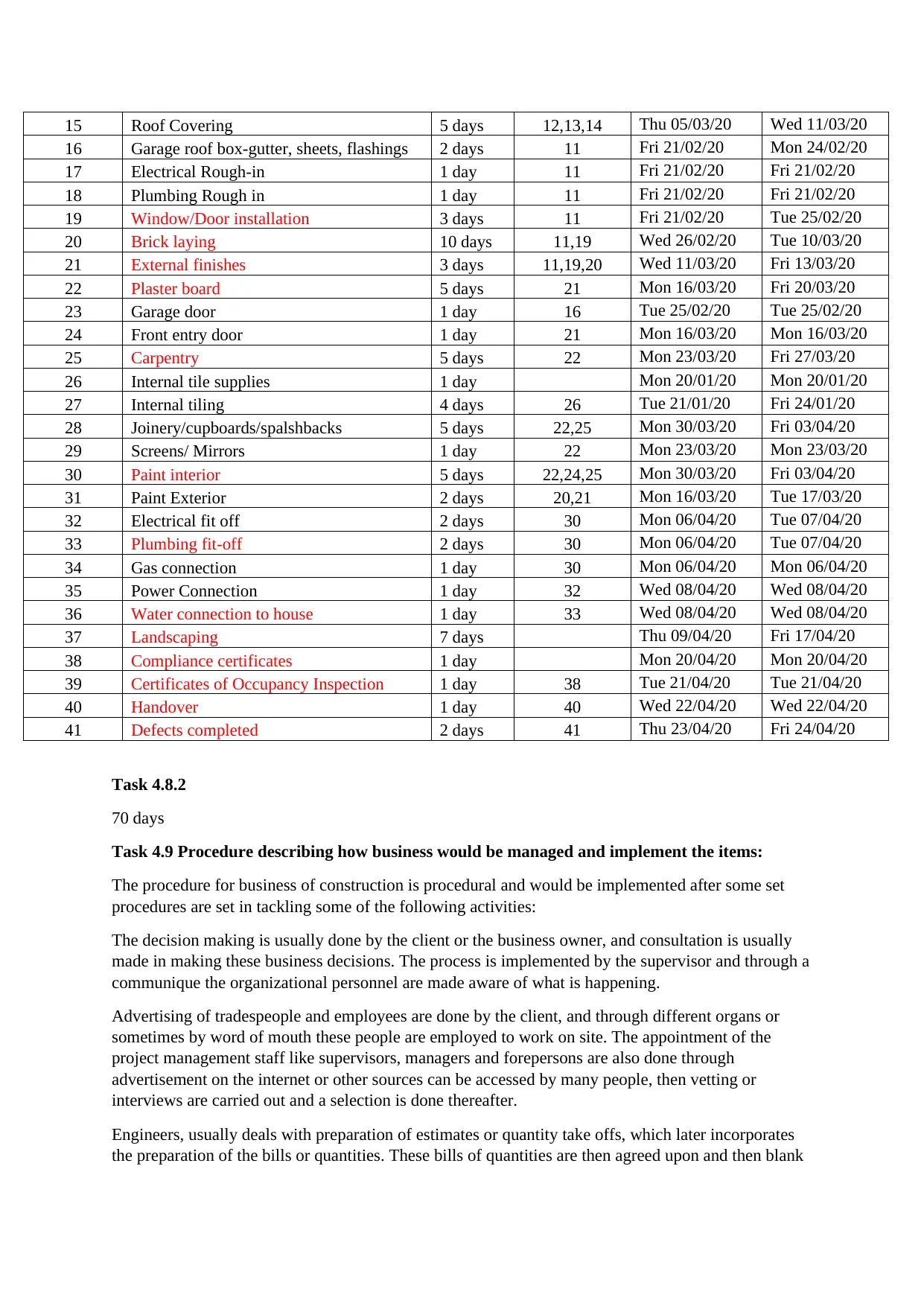
15 Roof Covering 5 days 12,13,14 Thu 05/03/20 Wed 11/03/20
16 Garage roof box-gutter, sheets, flashings 2 days 11 Fri 21/02/20 Mon 24/02/20
17 Electrical Rough-in 1 day 11 Fri 21/02/20 Fri 21/02/20
18 Plumbing Rough in 1 day 11 Fri 21/02/20 Fri 21/02/20
19 Window/Door installation 3 days 11 Fri 21/02/20 Tue 25/02/20
20 Brick laying 10 days 11,19 Wed 26/02/20 Tue 10/03/20
21 External finishes 3 days 11,19,20 Wed 11/03/20 Fri 13/03/20
22 Plaster board 5 days 21 Mon 16/03/20 Fri 20/03/20
23 Garage door 1 day 16 Tue 25/02/20 Tue 25/02/20
24 Front entry door 1 day 21 Mon 16/03/20 Mon 16/03/20
25 Carpentry 5 days 22 Mon 23/03/20 Fri 27/03/20
26 Internal tile supplies 1 day Mon 20/01/20 Mon 20/01/20
27 Internal tiling 4 days 26 Tue 21/01/20 Fri 24/01/20
28 Joinery/cupboards/spalshbacks 5 days 22,25 Mon 30/03/20 Fri 03/04/20
29 Screens/ Mirrors 1 day 22 Mon 23/03/20 Mon 23/03/20
30 Paint interior 5 days 22,24,25 Mon 30/03/20 Fri 03/04/20
31 Paint Exterior 2 days 20,21 Mon 16/03/20 Tue 17/03/20
32 Electrical fit off 2 days 30 Mon 06/04/20 Tue 07/04/20
33 Plumbing fit-off 2 days 30 Mon 06/04/20 Tue 07/04/20
34 Gas connection 1 day 30 Mon 06/04/20 Mon 06/04/20
35 Power Connection 1 day 32 Wed 08/04/20 Wed 08/04/20
36 Water connection to house 1 day 33 Wed 08/04/20 Wed 08/04/20
37 Landscaping 7 days Thu 09/04/20 Fri 17/04/20
38 Compliance certificates 1 day Mon 20/04/20 Mon 20/04/20
39 Certificates of Occupancy Inspection 1 day 38 Tue 21/04/20 Tue 21/04/20
40 Handover 1 day 40 Wed 22/04/20 Wed 22/04/20
41 Defects completed 2 days 41 Thu 23/04/20 Fri 24/04/20
Task 4.8.2
70 days
Task 4.9 Procedure describing how business would be managed and implement the items:
The procedure for business of construction is procedural and would be implemented after some set
procedures are set in tackling some of the following activities:
The decision making is usually done by the client or the business owner, and consultation is usually
made in making these business decisions. The process is implemented by the supervisor and through a
communique the organizational personnel are made aware of what is happening.
Advertising of tradespeople and employees are done by the client, and through different organs or
sometimes by word of mouth these people are employed to work on site. The appointment of the
project management staff like supervisors, managers and forepersons are also done through
advertisement on the internet or other sources can be accessed by many people, then vetting or
interviews are carried out and a selection is done thereafter.
Engineers, usually deals with preparation of estimates or quantity take offs, which later incorporates
the preparation of the bills or quantities. These bills of quantities are then agreed upon and then blank
16 Garage roof box-gutter, sheets, flashings 2 days 11 Fri 21/02/20 Mon 24/02/20
17 Electrical Rough-in 1 day 11 Fri 21/02/20 Fri 21/02/20
18 Plumbing Rough in 1 day 11 Fri 21/02/20 Fri 21/02/20
19 Window/Door installation 3 days 11 Fri 21/02/20 Tue 25/02/20
20 Brick laying 10 days 11,19 Wed 26/02/20 Tue 10/03/20
21 External finishes 3 days 11,19,20 Wed 11/03/20 Fri 13/03/20
22 Plaster board 5 days 21 Mon 16/03/20 Fri 20/03/20
23 Garage door 1 day 16 Tue 25/02/20 Tue 25/02/20
24 Front entry door 1 day 21 Mon 16/03/20 Mon 16/03/20
25 Carpentry 5 days 22 Mon 23/03/20 Fri 27/03/20
26 Internal tile supplies 1 day Mon 20/01/20 Mon 20/01/20
27 Internal tiling 4 days 26 Tue 21/01/20 Fri 24/01/20
28 Joinery/cupboards/spalshbacks 5 days 22,25 Mon 30/03/20 Fri 03/04/20
29 Screens/ Mirrors 1 day 22 Mon 23/03/20 Mon 23/03/20
30 Paint interior 5 days 22,24,25 Mon 30/03/20 Fri 03/04/20
31 Paint Exterior 2 days 20,21 Mon 16/03/20 Tue 17/03/20
32 Electrical fit off 2 days 30 Mon 06/04/20 Tue 07/04/20
33 Plumbing fit-off 2 days 30 Mon 06/04/20 Tue 07/04/20
34 Gas connection 1 day 30 Mon 06/04/20 Mon 06/04/20
35 Power Connection 1 day 32 Wed 08/04/20 Wed 08/04/20
36 Water connection to house 1 day 33 Wed 08/04/20 Wed 08/04/20
37 Landscaping 7 days Thu 09/04/20 Fri 17/04/20
38 Compliance certificates 1 day Mon 20/04/20 Mon 20/04/20
39 Certificates of Occupancy Inspection 1 day 38 Tue 21/04/20 Tue 21/04/20
40 Handover 1 day 40 Wed 22/04/20 Wed 22/04/20
41 Defects completed 2 days 41 Thu 23/04/20 Fri 24/04/20
Task 4.8.2
70 days
Task 4.9 Procedure describing how business would be managed and implement the items:
The procedure for business of construction is procedural and would be implemented after some set
procedures are set in tackling some of the following activities:
The decision making is usually done by the client or the business owner, and consultation is usually
made in making these business decisions. The process is implemented by the supervisor and through a
communique the organizational personnel are made aware of what is happening.
Advertising of tradespeople and employees are done by the client, and through different organs or
sometimes by word of mouth these people are employed to work on site. The appointment of the
project management staff like supervisors, managers and forepersons are also done through
advertisement on the internet or other sources can be accessed by many people, then vetting or
interviews are carried out and a selection is done thereafter.
Engineers, usually deals with preparation of estimates or quantity take offs, which later incorporates
the preparation of the bills or quantities. These bills of quantities are then agreed upon and then blank
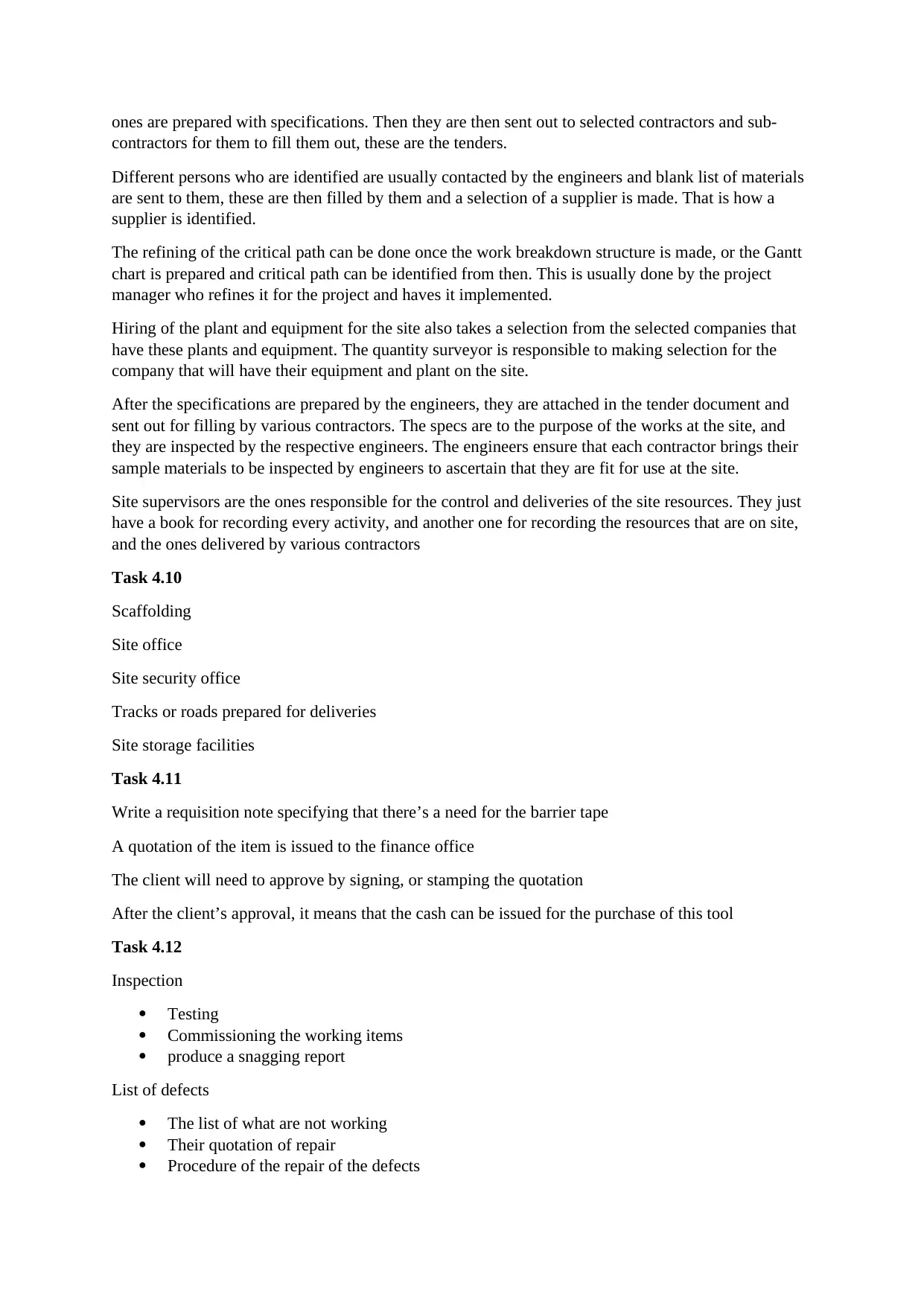
ones are prepared with specifications. Then they are then sent out to selected contractors and sub-
contractors for them to fill them out, these are the tenders.
Different persons who are identified are usually contacted by the engineers and blank list of materials
are sent to them, these are then filled by them and a selection of a supplier is made. That is how a
supplier is identified.
The refining of the critical path can be done once the work breakdown structure is made, or the Gantt
chart is prepared and critical path can be identified from then. This is usually done by the project
manager who refines it for the project and haves it implemented.
Hiring of the plant and equipment for the site also takes a selection from the selected companies that
have these plants and equipment. The quantity surveyor is responsible to making selection for the
company that will have their equipment and plant on the site.
After the specifications are prepared by the engineers, they are attached in the tender document and
sent out for filling by various contractors. The specs are to the purpose of the works at the site, and
they are inspected by the respective engineers. The engineers ensure that each contractor brings their
sample materials to be inspected by engineers to ascertain that they are fit for use at the site.
Site supervisors are the ones responsible for the control and deliveries of the site resources. They just
have a book for recording every activity, and another one for recording the resources that are on site,
and the ones delivered by various contractors
Task 4.10
Scaffolding
Site office
Site security office
Tracks or roads prepared for deliveries
Site storage facilities
Task 4.11
Write a requisition note specifying that there’s a need for the barrier tape
A quotation of the item is issued to the finance office
The client will need to approve by signing, or stamping the quotation
After the client’s approval, it means that the cash can be issued for the purchase of this tool
Task 4.12
Inspection
Testing
Commissioning the working items
produce a snagging report
List of defects
The list of what are not working
Their quotation of repair
Procedure of the repair of the defects
contractors for them to fill them out, these are the tenders.
Different persons who are identified are usually contacted by the engineers and blank list of materials
are sent to them, these are then filled by them and a selection of a supplier is made. That is how a
supplier is identified.
The refining of the critical path can be done once the work breakdown structure is made, or the Gantt
chart is prepared and critical path can be identified from then. This is usually done by the project
manager who refines it for the project and haves it implemented.
Hiring of the plant and equipment for the site also takes a selection from the selected companies that
have these plants and equipment. The quantity surveyor is responsible to making selection for the
company that will have their equipment and plant on the site.
After the specifications are prepared by the engineers, they are attached in the tender document and
sent out for filling by various contractors. The specs are to the purpose of the works at the site, and
they are inspected by the respective engineers. The engineers ensure that each contractor brings their
sample materials to be inspected by engineers to ascertain that they are fit for use at the site.
Site supervisors are the ones responsible for the control and deliveries of the site resources. They just
have a book for recording every activity, and another one for recording the resources that are on site,
and the ones delivered by various contractors
Task 4.10
Scaffolding
Site office
Site security office
Tracks or roads prepared for deliveries
Site storage facilities
Task 4.11
Write a requisition note specifying that there’s a need for the barrier tape
A quotation of the item is issued to the finance office
The client will need to approve by signing, or stamping the quotation
After the client’s approval, it means that the cash can be issued for the purchase of this tool
Task 4.12
Inspection
Testing
Commissioning the working items
produce a snagging report
List of defects
The list of what are not working
Their quotation of repair
Procedure of the repair of the defects
Secure Best Marks with AI Grader
Need help grading? Try our AI Grader for instant feedback on your assignments.
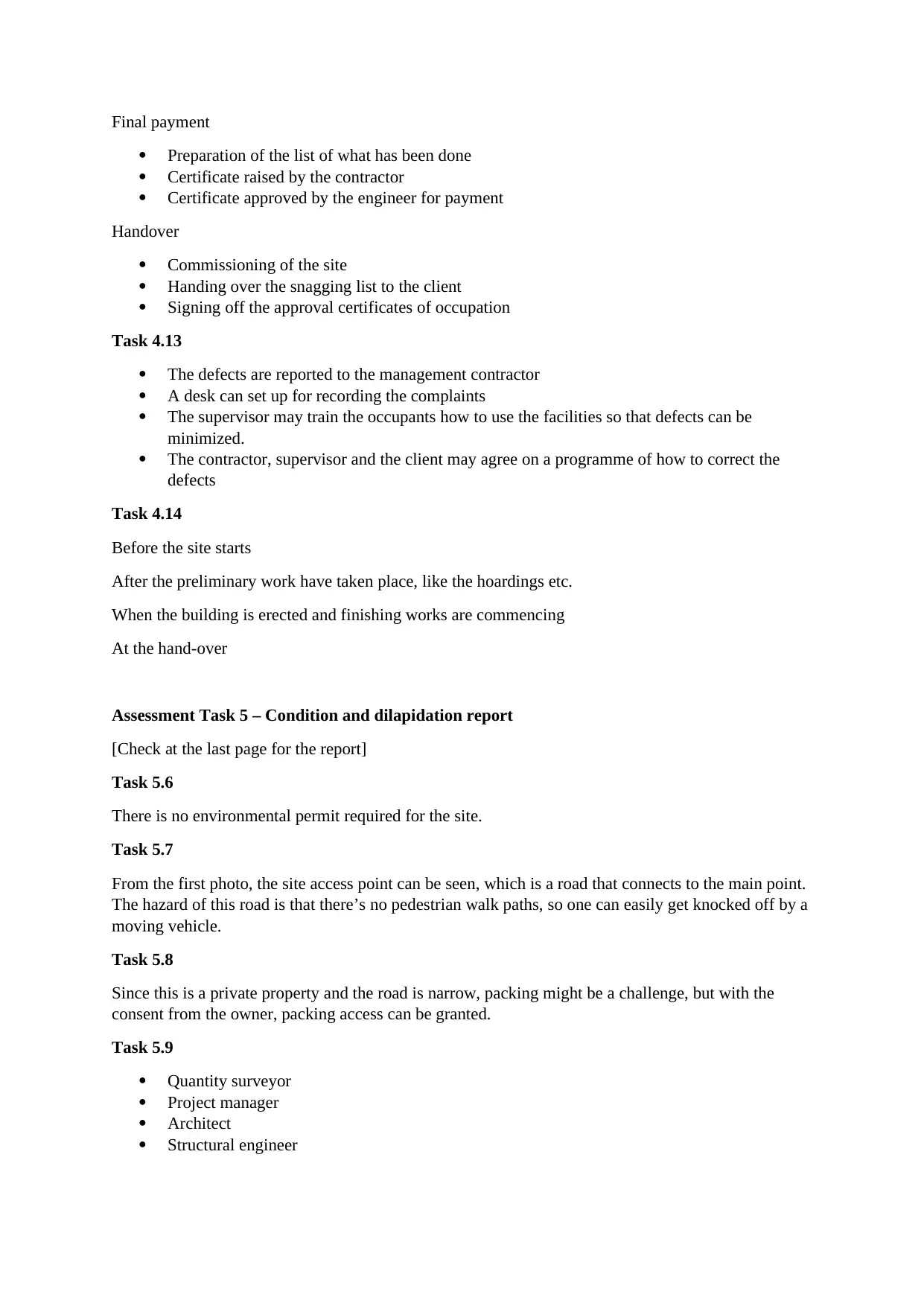
Final payment
Preparation of the list of what has been done
Certificate raised by the contractor
Certificate approved by the engineer for payment
Handover
Commissioning of the site
Handing over the snagging list to the client
Signing off the approval certificates of occupation
Task 4.13
The defects are reported to the management contractor
A desk can set up for recording the complaints
The supervisor may train the occupants how to use the facilities so that defects can be
minimized.
The contractor, supervisor and the client may agree on a programme of how to correct the
defects
Task 4.14
Before the site starts
After the preliminary work have taken place, like the hoardings etc.
When the building is erected and finishing works are commencing
At the hand-over
Assessment Task 5 – Condition and dilapidation report
[Check at the last page for the report]
Task 5.6
There is no environmental permit required for the site.
Task 5.7
From the first photo, the site access point can be seen, which is a road that connects to the main point.
The hazard of this road is that there’s no pedestrian walk paths, so one can easily get knocked off by a
moving vehicle.
Task 5.8
Since this is a private property and the road is narrow, packing might be a challenge, but with the
consent from the owner, packing access can be granted.
Task 5.9
Quantity surveyor
Project manager
Architect
Structural engineer
Preparation of the list of what has been done
Certificate raised by the contractor
Certificate approved by the engineer for payment
Handover
Commissioning of the site
Handing over the snagging list to the client
Signing off the approval certificates of occupation
Task 4.13
The defects are reported to the management contractor
A desk can set up for recording the complaints
The supervisor may train the occupants how to use the facilities so that defects can be
minimized.
The contractor, supervisor and the client may agree on a programme of how to correct the
defects
Task 4.14
Before the site starts
After the preliminary work have taken place, like the hoardings etc.
When the building is erected and finishing works are commencing
At the hand-over
Assessment Task 5 – Condition and dilapidation report
[Check at the last page for the report]
Task 5.6
There is no environmental permit required for the site.
Task 5.7
From the first photo, the site access point can be seen, which is a road that connects to the main point.
The hazard of this road is that there’s no pedestrian walk paths, so one can easily get knocked off by a
moving vehicle.
Task 5.8
Since this is a private property and the road is narrow, packing might be a challenge, but with the
consent from the owner, packing access can be granted.
Task 5.9
Quantity surveyor
Project manager
Architect
Structural engineer
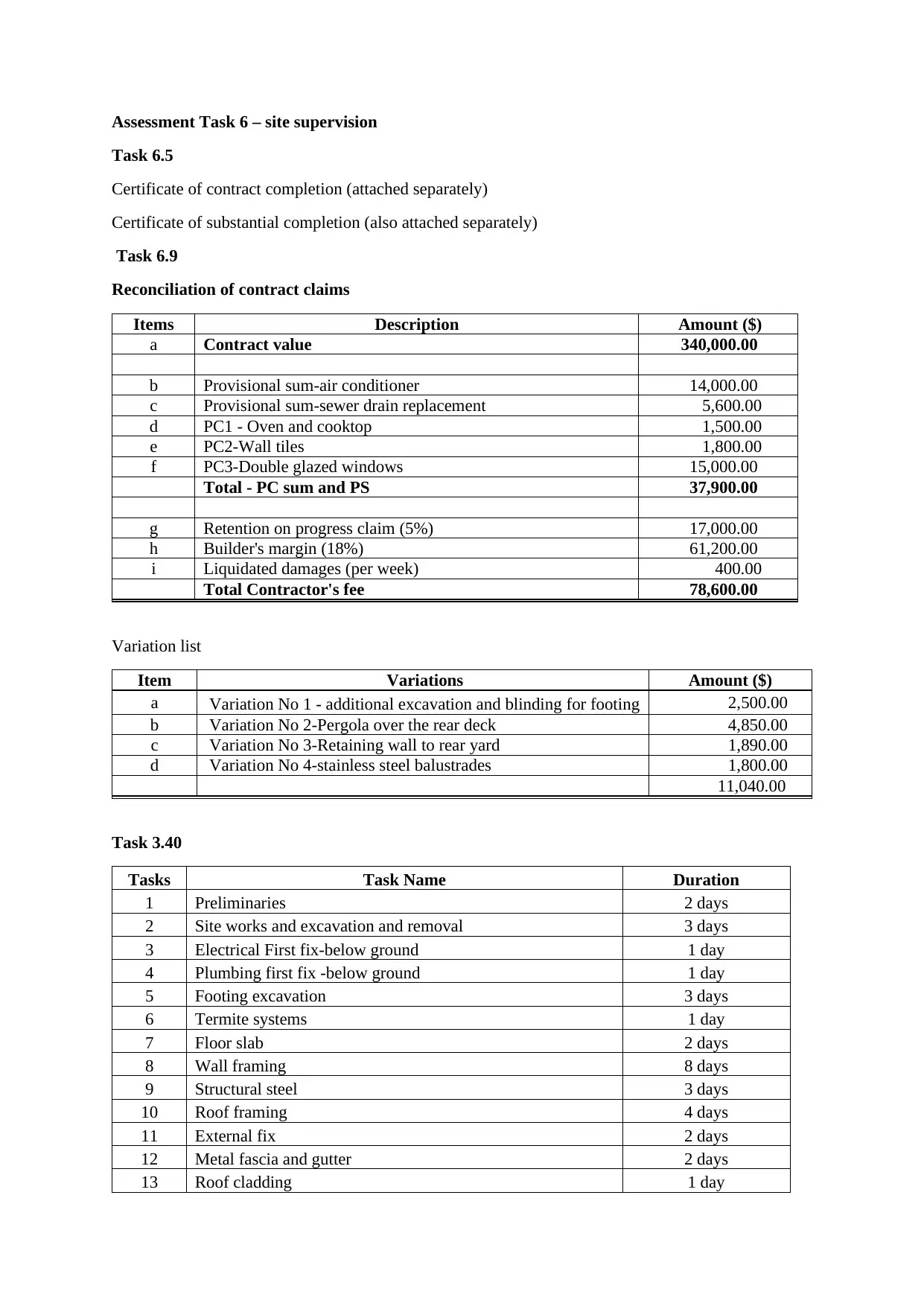
Assessment Task 6 – site supervision
Task 6.5
Certificate of contract completion (attached separately)
Certificate of substantial completion (also attached separately)
Task 6.9
Reconciliation of contract claims
Items Description Amount ($)
a Contract value 340,000.00
b Provisional sum-air conditioner 14,000.00
c Provisional sum-sewer drain replacement 5,600.00
d PC1 - Oven and cooktop 1,500.00
e PC2-Wall tiles 1,800.00
f PC3-Double glazed windows 15,000.00
Total - PC sum and PS 37,900.00
g Retention on progress claim (5%) 17,000.00
h Builder's margin (18%) 61,200.00
i Liquidated damages (per week) 400.00
Total Contractor's fee 78,600.00
Variation list
Item Variations Amount ($)
a Variation No 1 - additional excavation and blinding for footing 2,500.00
b Variation No 2-Pergola over the rear deck 4,850.00
c Variation No 3-Retaining wall to rear yard 1,890.00
d Variation No 4-stainless steel balustrades 1,800.00
11,040.00
Task 3.40
Tasks Task Name Duration
1 Preliminaries 2 days
2 Site works and excavation and removal 3 days
3 Electrical First fix-below ground 1 day
4 Plumbing first fix -below ground 1 day
5 Footing excavation 3 days
6 Termite systems 1 day
7 Floor slab 2 days
8 Wall framing 8 days
9 Structural steel 3 days
10 Roof framing 4 days
11 External fix 2 days
12 Metal fascia and gutter 2 days
13 Roof cladding 1 day
Task 6.5
Certificate of contract completion (attached separately)
Certificate of substantial completion (also attached separately)
Task 6.9
Reconciliation of contract claims
Items Description Amount ($)
a Contract value 340,000.00
b Provisional sum-air conditioner 14,000.00
c Provisional sum-sewer drain replacement 5,600.00
d PC1 - Oven and cooktop 1,500.00
e PC2-Wall tiles 1,800.00
f PC3-Double glazed windows 15,000.00
Total - PC sum and PS 37,900.00
g Retention on progress claim (5%) 17,000.00
h Builder's margin (18%) 61,200.00
i Liquidated damages (per week) 400.00
Total Contractor's fee 78,600.00
Variation list
Item Variations Amount ($)
a Variation No 1 - additional excavation and blinding for footing 2,500.00
b Variation No 2-Pergola over the rear deck 4,850.00
c Variation No 3-Retaining wall to rear yard 1,890.00
d Variation No 4-stainless steel balustrades 1,800.00
11,040.00
Task 3.40
Tasks Task Name Duration
1 Preliminaries 2 days
2 Site works and excavation and removal 3 days
3 Electrical First fix-below ground 1 day
4 Plumbing first fix -below ground 1 day
5 Footing excavation 3 days
6 Termite systems 1 day
7 Floor slab 2 days
8 Wall framing 8 days
9 Structural steel 3 days
10 Roof framing 4 days
11 External fix 2 days
12 Metal fascia and gutter 2 days
13 Roof cladding 1 day
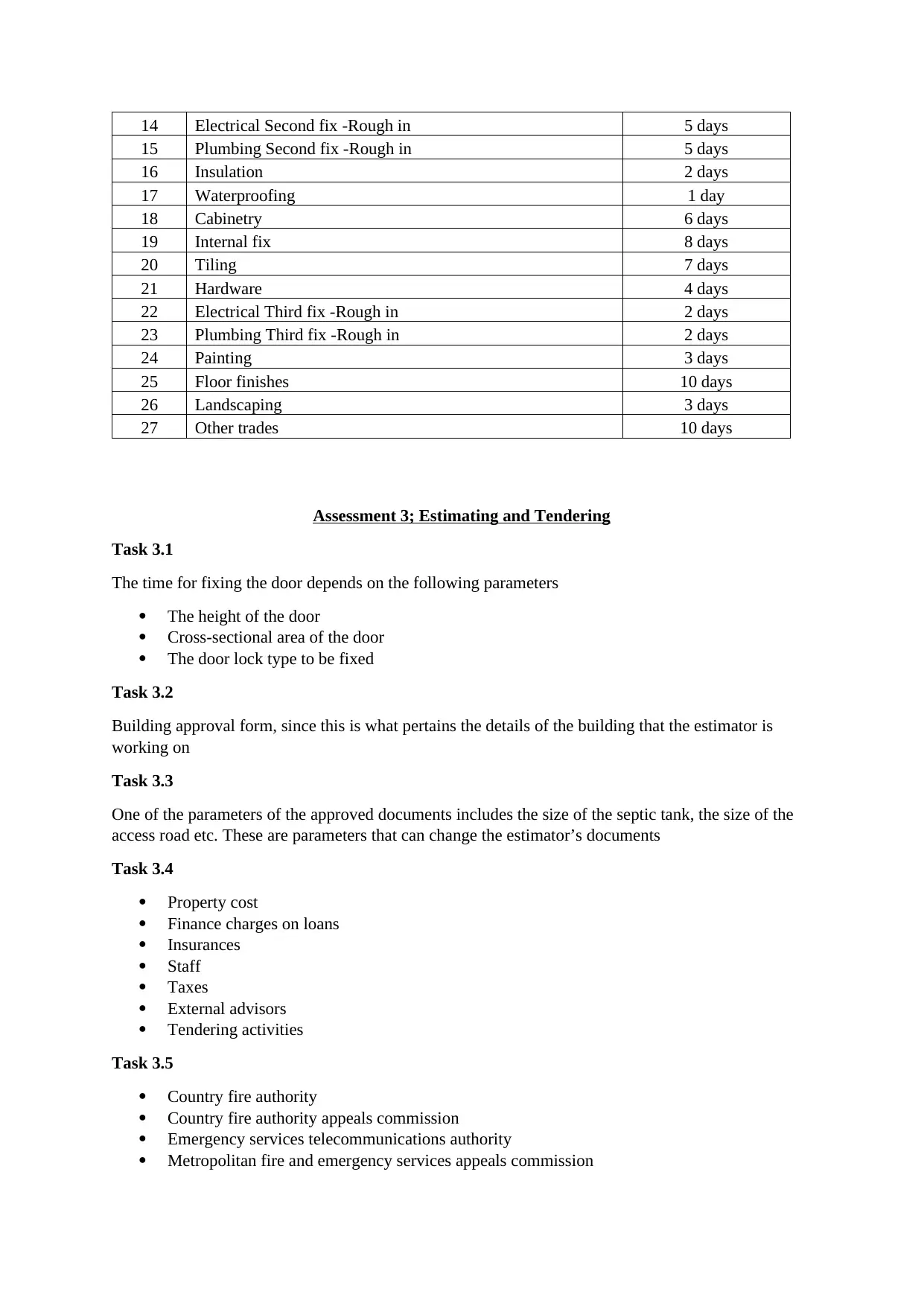
14 Electrical Second fix -Rough in 5 days
15 Plumbing Second fix -Rough in 5 days
16 Insulation 2 days
17 Waterproofing 1 day
18 Cabinetry 6 days
19 Internal fix 8 days
20 Tiling 7 days
21 Hardware 4 days
22 Electrical Third fix -Rough in 2 days
23 Plumbing Third fix -Rough in 2 days
24 Painting 3 days
25 Floor finishes 10 days
26 Landscaping 3 days
27 Other trades 10 days
Assessment 3; Estimating and Tendering
Task 3.1
The time for fixing the door depends on the following parameters
The height of the door
Cross-sectional area of the door
The door lock type to be fixed
Task 3.2
Building approval form, since this is what pertains the details of the building that the estimator is
working on
Task 3.3
One of the parameters of the approved documents includes the size of the septic tank, the size of the
access road etc. These are parameters that can change the estimator’s documents
Task 3.4
Property cost
Finance charges on loans
Insurances
Staff
Taxes
External advisors
Tendering activities
Task 3.5
Country fire authority
Country fire authority appeals commission
Emergency services telecommunications authority
Metropolitan fire and emergency services appeals commission
15 Plumbing Second fix -Rough in 5 days
16 Insulation 2 days
17 Waterproofing 1 day
18 Cabinetry 6 days
19 Internal fix 8 days
20 Tiling 7 days
21 Hardware 4 days
22 Electrical Third fix -Rough in 2 days
23 Plumbing Third fix -Rough in 2 days
24 Painting 3 days
25 Floor finishes 10 days
26 Landscaping 3 days
27 Other trades 10 days
Assessment 3; Estimating and Tendering
Task 3.1
The time for fixing the door depends on the following parameters
The height of the door
Cross-sectional area of the door
The door lock type to be fixed
Task 3.2
Building approval form, since this is what pertains the details of the building that the estimator is
working on
Task 3.3
One of the parameters of the approved documents includes the size of the septic tank, the size of the
access road etc. These are parameters that can change the estimator’s documents
Task 3.4
Property cost
Finance charges on loans
Insurances
Staff
Taxes
External advisors
Tendering activities
Task 3.5
Country fire authority
Country fire authority appeals commission
Emergency services telecommunications authority
Metropolitan fire and emergency services appeals commission
Paraphrase This Document
Need a fresh take? Get an instant paraphrase of this document with our AI Paraphraser
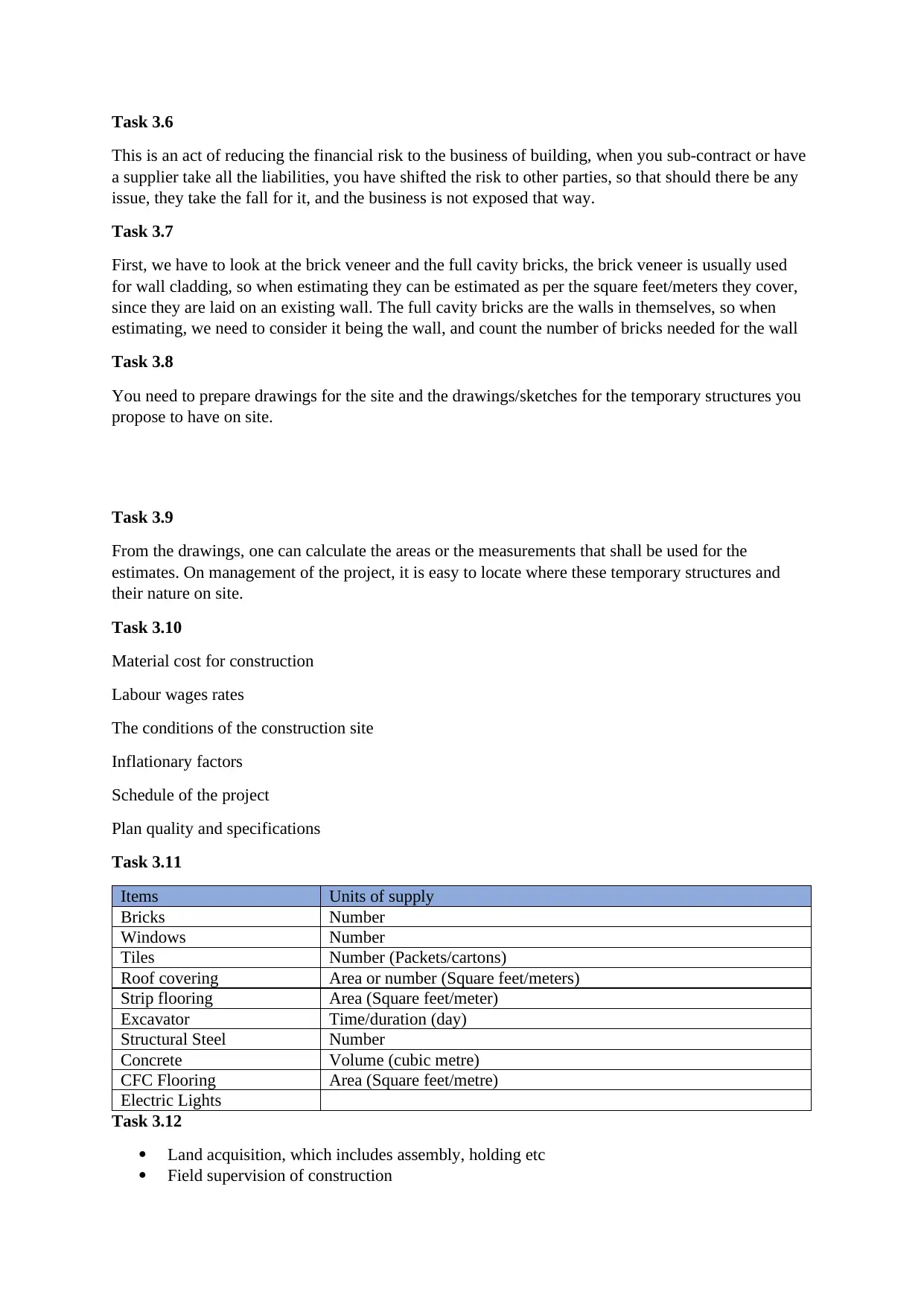
Task 3.6
This is an act of reducing the financial risk to the business of building, when you sub-contract or have
a supplier take all the liabilities, you have shifted the risk to other parties, so that should there be any
issue, they take the fall for it, and the business is not exposed that way.
Task 3.7
First, we have to look at the brick veneer and the full cavity bricks, the brick veneer is usually used
for wall cladding, so when estimating they can be estimated as per the square feet/meters they cover,
since they are laid on an existing wall. The full cavity bricks are the walls in themselves, so when
estimating, we need to consider it being the wall, and count the number of bricks needed for the wall
Task 3.8
You need to prepare drawings for the site and the drawings/sketches for the temporary structures you
propose to have on site.
Task 3.9
From the drawings, one can calculate the areas or the measurements that shall be used for the
estimates. On management of the project, it is easy to locate where these temporary structures and
their nature on site.
Task 3.10
Material cost for construction
Labour wages rates
The conditions of the construction site
Inflationary factors
Schedule of the project
Plan quality and specifications
Task 3.11
Items Units of supply
Bricks Number
Windows Number
Tiles Number (Packets/cartons)
Roof covering Area or number (Square feet/meters)
Strip flooring Area (Square feet/meter)
Excavator Time/duration (day)
Structural Steel Number
Concrete Volume (cubic metre)
CFC Flooring Area (Square feet/metre)
Electric Lights
Task 3.12
Land acquisition, which includes assembly, holding etc
Field supervision of construction
This is an act of reducing the financial risk to the business of building, when you sub-contract or have
a supplier take all the liabilities, you have shifted the risk to other parties, so that should there be any
issue, they take the fall for it, and the business is not exposed that way.
Task 3.7
First, we have to look at the brick veneer and the full cavity bricks, the brick veneer is usually used
for wall cladding, so when estimating they can be estimated as per the square feet/meters they cover,
since they are laid on an existing wall. The full cavity bricks are the walls in themselves, so when
estimating, we need to consider it being the wall, and count the number of bricks needed for the wall
Task 3.8
You need to prepare drawings for the site and the drawings/sketches for the temporary structures you
propose to have on site.
Task 3.9
From the drawings, one can calculate the areas or the measurements that shall be used for the
estimates. On management of the project, it is easy to locate where these temporary structures and
their nature on site.
Task 3.10
Material cost for construction
Labour wages rates
The conditions of the construction site
Inflationary factors
Schedule of the project
Plan quality and specifications
Task 3.11
Items Units of supply
Bricks Number
Windows Number
Tiles Number (Packets/cartons)
Roof covering Area or number (Square feet/meters)
Strip flooring Area (Square feet/meter)
Excavator Time/duration (day)
Structural Steel Number
Concrete Volume (cubic metre)
CFC Flooring Area (Square feet/metre)
Electric Lights
Task 3.12
Land acquisition, which includes assembly, holding etc
Field supervision of construction
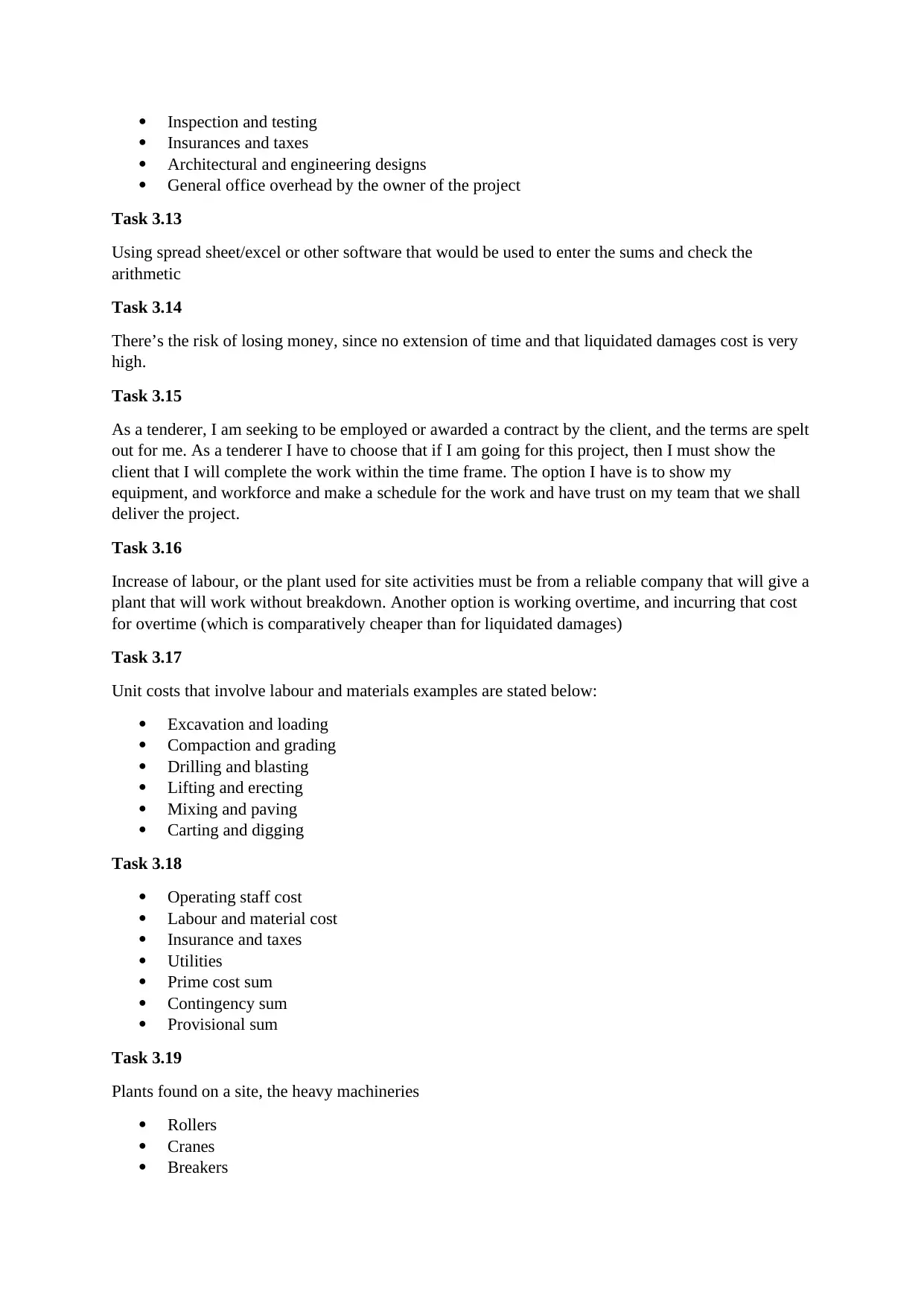
Inspection and testing
Insurances and taxes
Architectural and engineering designs
General office overhead by the owner of the project
Task 3.13
Using spread sheet/excel or other software that would be used to enter the sums and check the
arithmetic
Task 3.14
There’s the risk of losing money, since no extension of time and that liquidated damages cost is very
high.
Task 3.15
As a tenderer, I am seeking to be employed or awarded a contract by the client, and the terms are spelt
out for me. As a tenderer I have to choose that if I am going for this project, then I must show the
client that I will complete the work within the time frame. The option I have is to show my
equipment, and workforce and make a schedule for the work and have trust on my team that we shall
deliver the project.
Task 3.16
Increase of labour, or the plant used for site activities must be from a reliable company that will give a
plant that will work without breakdown. Another option is working overtime, and incurring that cost
for overtime (which is comparatively cheaper than for liquidated damages)
Task 3.17
Unit costs that involve labour and materials examples are stated below:
Excavation and loading
Compaction and grading
Drilling and blasting
Lifting and erecting
Mixing and paving
Carting and digging
Task 3.18
Operating staff cost
Labour and material cost
Insurance and taxes
Utilities
Prime cost sum
Contingency sum
Provisional sum
Task 3.19
Plants found on a site, the heavy machineries
Rollers
Cranes
Breakers
Insurances and taxes
Architectural and engineering designs
General office overhead by the owner of the project
Task 3.13
Using spread sheet/excel or other software that would be used to enter the sums and check the
arithmetic
Task 3.14
There’s the risk of losing money, since no extension of time and that liquidated damages cost is very
high.
Task 3.15
As a tenderer, I am seeking to be employed or awarded a contract by the client, and the terms are spelt
out for me. As a tenderer I have to choose that if I am going for this project, then I must show the
client that I will complete the work within the time frame. The option I have is to show my
equipment, and workforce and make a schedule for the work and have trust on my team that we shall
deliver the project.
Task 3.16
Increase of labour, or the plant used for site activities must be from a reliable company that will give a
plant that will work without breakdown. Another option is working overtime, and incurring that cost
for overtime (which is comparatively cheaper than for liquidated damages)
Task 3.17
Unit costs that involve labour and materials examples are stated below:
Excavation and loading
Compaction and grading
Drilling and blasting
Lifting and erecting
Mixing and paving
Carting and digging
Task 3.18
Operating staff cost
Labour and material cost
Insurance and taxes
Utilities
Prime cost sum
Contingency sum
Provisional sum
Task 3.19
Plants found on a site, the heavy machineries
Rollers
Cranes
Breakers
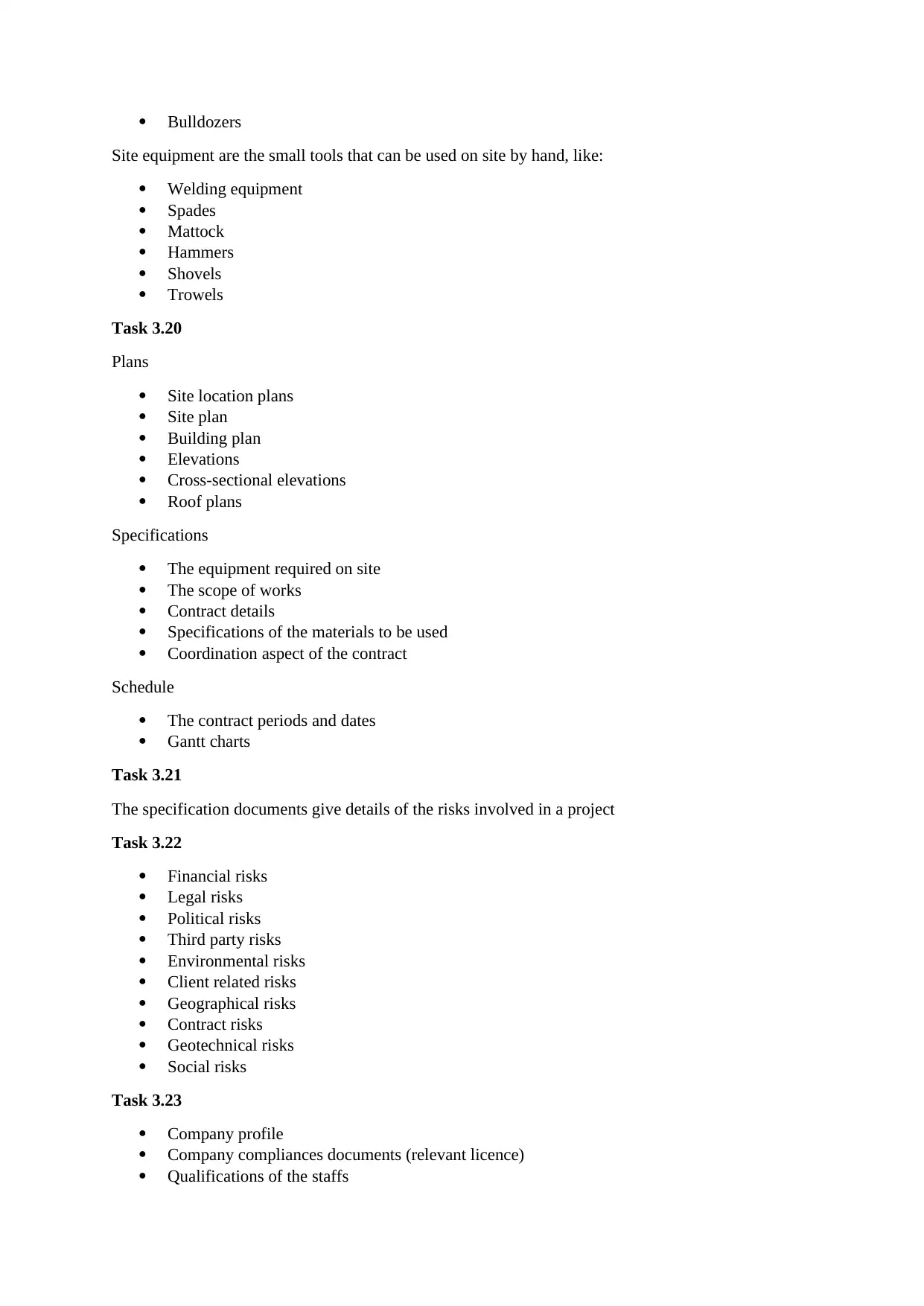
Bulldozers
Site equipment are the small tools that can be used on site by hand, like:
Welding equipment
Spades
Mattock
Hammers
Shovels
Trowels
Task 3.20
Plans
Site location plans
Site plan
Building plan
Elevations
Cross-sectional elevations
Roof plans
Specifications
The equipment required on site
The scope of works
Contract details
Specifications of the materials to be used
Coordination aspect of the contract
Schedule
The contract periods and dates
Gantt charts
Task 3.21
The specification documents give details of the risks involved in a project
Task 3.22
Financial risks
Legal risks
Political risks
Third party risks
Environmental risks
Client related risks
Geographical risks
Contract risks
Geotechnical risks
Social risks
Task 3.23
Company profile
Company compliances documents (relevant licence)
Qualifications of the staffs
Site equipment are the small tools that can be used on site by hand, like:
Welding equipment
Spades
Mattock
Hammers
Shovels
Trowels
Task 3.20
Plans
Site location plans
Site plan
Building plan
Elevations
Cross-sectional elevations
Roof plans
Specifications
The equipment required on site
The scope of works
Contract details
Specifications of the materials to be used
Coordination aspect of the contract
Schedule
The contract periods and dates
Gantt charts
Task 3.21
The specification documents give details of the risks involved in a project
Task 3.22
Financial risks
Legal risks
Political risks
Third party risks
Environmental risks
Client related risks
Geographical risks
Contract risks
Geotechnical risks
Social risks
Task 3.23
Company profile
Company compliances documents (relevant licence)
Qualifications of the staffs
Secure Best Marks with AI Grader
Need help grading? Try our AI Grader for instant feedback on your assignments.
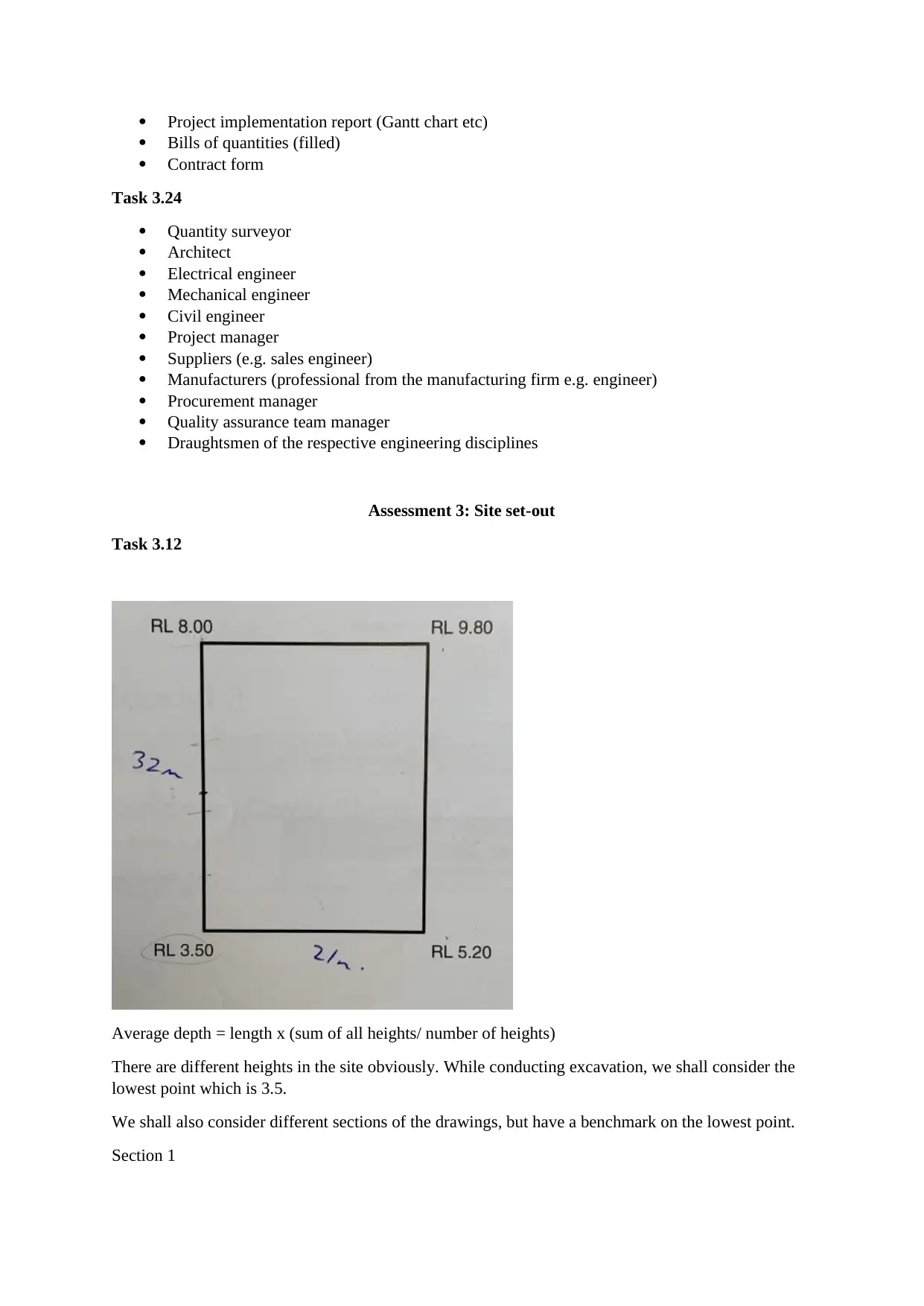
Project implementation report (Gantt chart etc)
Bills of quantities (filled)
Contract form
Task 3.24
Quantity surveyor
Architect
Electrical engineer
Mechanical engineer
Civil engineer
Project manager
Suppliers (e.g. sales engineer)
Manufacturers (professional from the manufacturing firm e.g. engineer)
Procurement manager
Quality assurance team manager
Draughtsmen of the respective engineering disciplines
Assessment 3: Site set-out
Task 3.12
Average depth = length x (sum of all heights/ number of heights)
There are different heights in the site obviously. While conducting excavation, we shall consider the
lowest point which is 3.5.
We shall also consider different sections of the drawings, but have a benchmark on the lowest point.
Section 1
Bills of quantities (filled)
Contract form
Task 3.24
Quantity surveyor
Architect
Electrical engineer
Mechanical engineer
Civil engineer
Project manager
Suppliers (e.g. sales engineer)
Manufacturers (professional from the manufacturing firm e.g. engineer)
Procurement manager
Quality assurance team manager
Draughtsmen of the respective engineering disciplines
Assessment 3: Site set-out
Task 3.12
Average depth = length x (sum of all heights/ number of heights)
There are different heights in the site obviously. While conducting excavation, we shall consider the
lowest point which is 3.5.
We shall also consider different sections of the drawings, but have a benchmark on the lowest point.
Section 1
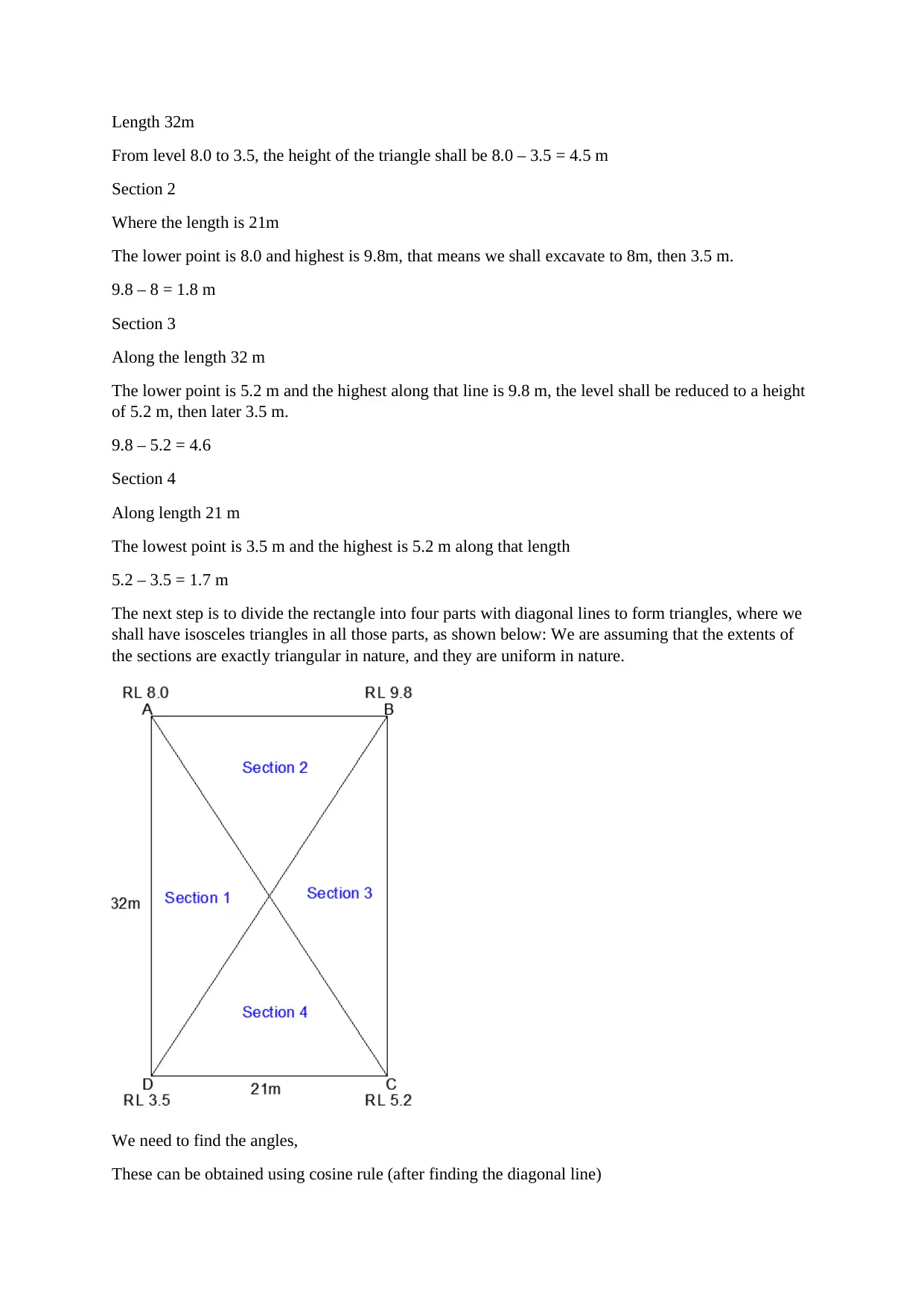
Length 32m
From level 8.0 to 3.5, the height of the triangle shall be 8.0 – 3.5 = 4.5 m
Section 2
Where the length is 21m
The lower point is 8.0 and highest is 9.8m, that means we shall excavate to 8m, then 3.5 m.
9.8 – 8 = 1.8 m
Section 3
Along the length 32 m
The lower point is 5.2 m and the highest along that line is 9.8 m, the level shall be reduced to a height
of 5.2 m, then later 3.5 m.
9.8 – 5.2 = 4.6
Section 4
Along length 21 m
The lowest point is 3.5 m and the highest is 5.2 m along that length
5.2 – 3.5 = 1.7 m
The next step is to divide the rectangle into four parts with diagonal lines to form triangles, where we
shall have isosceles triangles in all those parts, as shown below: We are assuming that the extents of
the sections are exactly triangular in nature, and they are uniform in nature.
We need to find the angles,
These can be obtained using cosine rule (after finding the diagonal line)
From level 8.0 to 3.5, the height of the triangle shall be 8.0 – 3.5 = 4.5 m
Section 2
Where the length is 21m
The lower point is 8.0 and highest is 9.8m, that means we shall excavate to 8m, then 3.5 m.
9.8 – 8 = 1.8 m
Section 3
Along the length 32 m
The lower point is 5.2 m and the highest along that line is 9.8 m, the level shall be reduced to a height
of 5.2 m, then later 3.5 m.
9.8 – 5.2 = 4.6
Section 4
Along length 21 m
The lowest point is 3.5 m and the highest is 5.2 m along that length
5.2 – 3.5 = 1.7 m
The next step is to divide the rectangle into four parts with diagonal lines to form triangles, where we
shall have isosceles triangles in all those parts, as shown below: We are assuming that the extents of
the sections are exactly triangular in nature, and they are uniform in nature.
We need to find the angles,
These can be obtained using cosine rule (after finding the diagonal line)
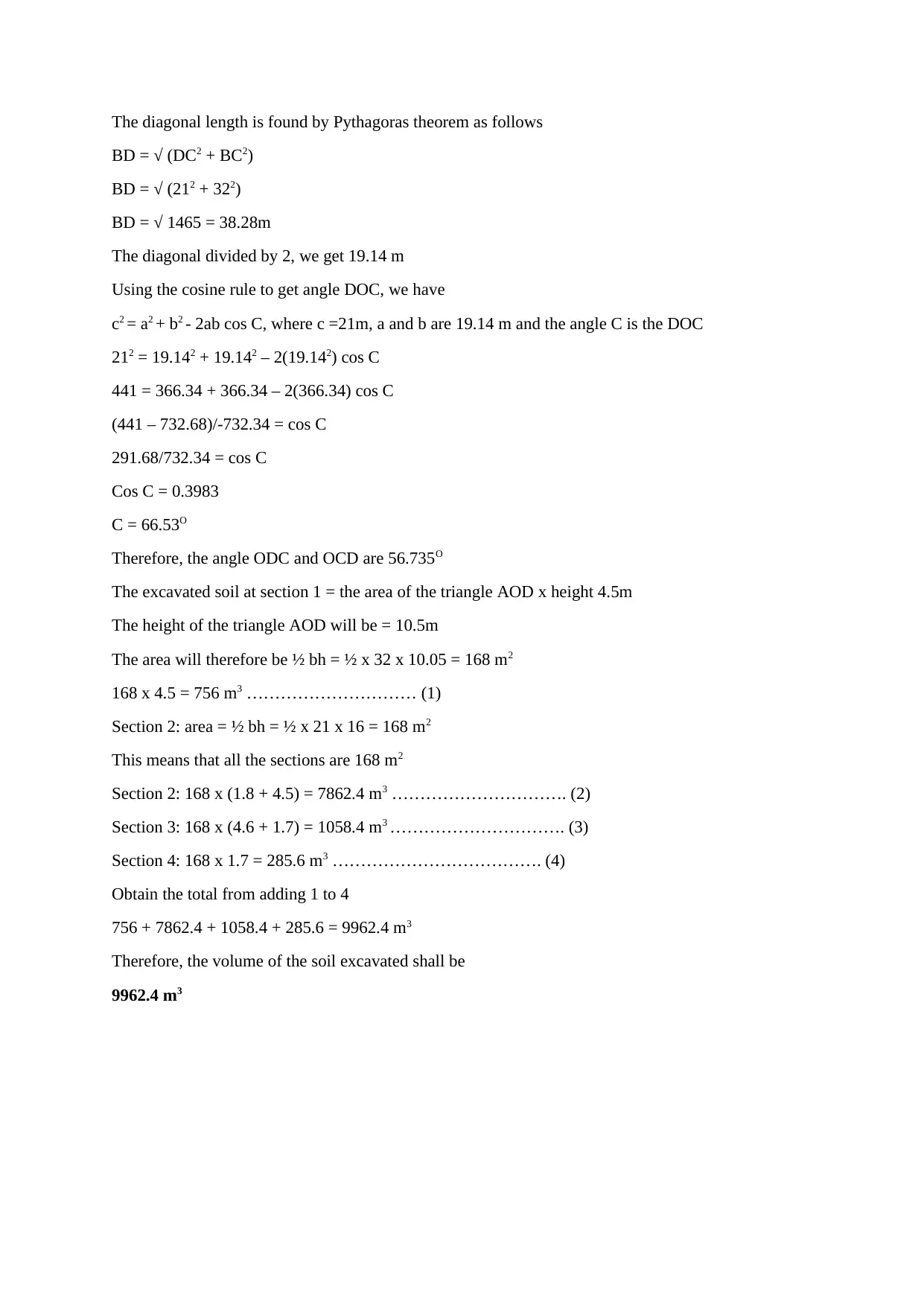
The diagonal length is found by Pythagoras theorem as follows
BD = √ (DC2 + BC2)
BD = √ (212 + 322)
BD = √ 1465 = 38.28m
The diagonal divided by 2, we get 19.14 m
Using the cosine rule to get angle DOC, we have
c2 = a2 + b2 - 2ab cos C, where c =21m, a and b are 19.14 m and the angle C is the DOC
212 = 19.142 + 19.142 – 2(19.142) cos C
441 = 366.34 + 366.34 – 2(366.34) cos C
(441 – 732.68)/-732.34 = cos C
291.68/732.34 = cos C
Cos C = 0.3983
C = 66.53O
Therefore, the angle ODC and OCD are 56.735O
The excavated soil at section 1 = the area of the triangle AOD x height 4.5m
The height of the triangle AOD will be = 10.5m
The area will therefore be ½ bh = ½ x 32 x 10.05 = 168 m2
168 x 4.5 = 756 m3 ………………………… (1)
Section 2: area = ½ bh = ½ x 21 x 16 = 168 m2
This means that all the sections are 168 m2
Section 2: 168 x (1.8 + 4.5) = 7862.4 m3 …………………………. (2)
Section 3: 168 x (4.6 + 1.7) = 1058.4 m3 …………………………. (3)
Section 4: 168 x 1.7 = 285.6 m3 ………………………………. (4)
Obtain the total from adding 1 to 4
756 + 7862.4 + 1058.4 + 285.6 = 9962.4 m3
Therefore, the volume of the soil excavated shall be
9962.4 m3
BD = √ (DC2 + BC2)
BD = √ (212 + 322)
BD = √ 1465 = 38.28m
The diagonal divided by 2, we get 19.14 m
Using the cosine rule to get angle DOC, we have
c2 = a2 + b2 - 2ab cos C, where c =21m, a and b are 19.14 m and the angle C is the DOC
212 = 19.142 + 19.142 – 2(19.142) cos C
441 = 366.34 + 366.34 – 2(366.34) cos C
(441 – 732.68)/-732.34 = cos C
291.68/732.34 = cos C
Cos C = 0.3983
C = 66.53O
Therefore, the angle ODC and OCD are 56.735O
The excavated soil at section 1 = the area of the triangle AOD x height 4.5m
The height of the triangle AOD will be = 10.5m
The area will therefore be ½ bh = ½ x 32 x 10.05 = 168 m2
168 x 4.5 = 756 m3 ………………………… (1)
Section 2: area = ½ bh = ½ x 21 x 16 = 168 m2
This means that all the sections are 168 m2
Section 2: 168 x (1.8 + 4.5) = 7862.4 m3 …………………………. (2)
Section 3: 168 x (4.6 + 1.7) = 1058.4 m3 …………………………. (3)
Section 4: 168 x 1.7 = 285.6 m3 ………………………………. (4)
Obtain the total from adding 1 to 4
756 + 7862.4 + 1058.4 + 285.6 = 9962.4 m3
Therefore, the volume of the soil excavated shall be
9962.4 m3
Paraphrase This Document
Need a fresh take? Get an instant paraphrase of this document with our AI Paraphraser
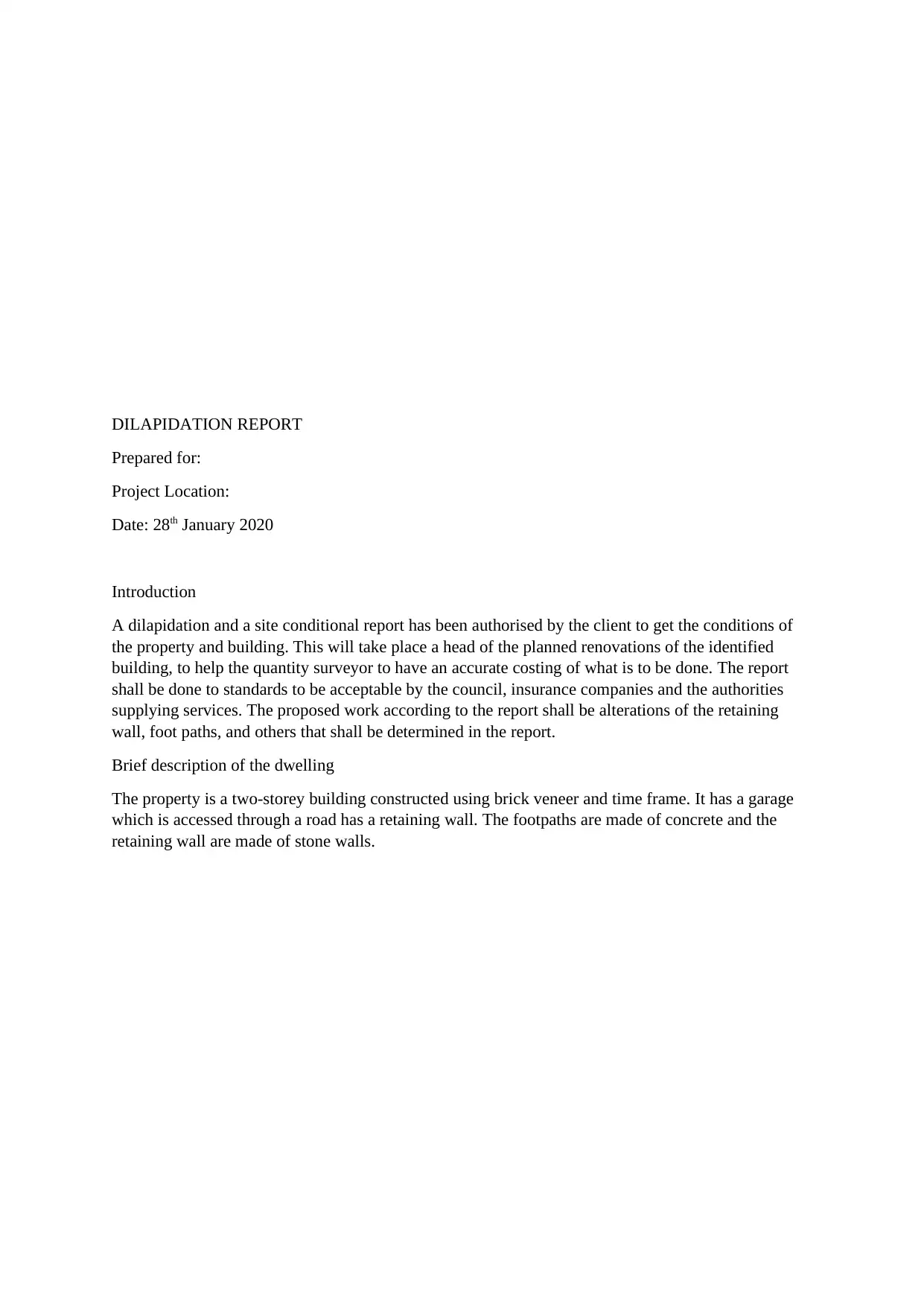
DILAPIDATION REPORT
Prepared for:
Project Location:
Date: 28th January 2020
Introduction
A dilapidation and a site conditional report has been authorised by the client to get the conditions of
the property and building. This will take place a head of the planned renovations of the identified
building, to help the quantity surveyor to have an accurate costing of what is to be done. The report
shall be done to standards to be acceptable by the council, insurance companies and the authorities
supplying services. The proposed work according to the report shall be alterations of the retaining
wall, foot paths, and others that shall be determined in the report.
Brief description of the dwelling
The property is a two-storey building constructed using brick veneer and time frame. It has a garage
which is accessed through a road has a retaining wall. The footpaths are made of concrete and the
retaining wall are made of stone walls.
Prepared for:
Project Location:
Date: 28th January 2020
Introduction
A dilapidation and a site conditional report has been authorised by the client to get the conditions of
the property and building. This will take place a head of the planned renovations of the identified
building, to help the quantity surveyor to have an accurate costing of what is to be done. The report
shall be done to standards to be acceptable by the council, insurance companies and the authorities
supplying services. The proposed work according to the report shall be alterations of the retaining
wall, foot paths, and others that shall be determined in the report.
Brief description of the dwelling
The property is a two-storey building constructed using brick veneer and time frame. It has a garage
which is accessed through a road has a retaining wall. The footpaths are made of concrete and the
retaining wall are made of stone walls.
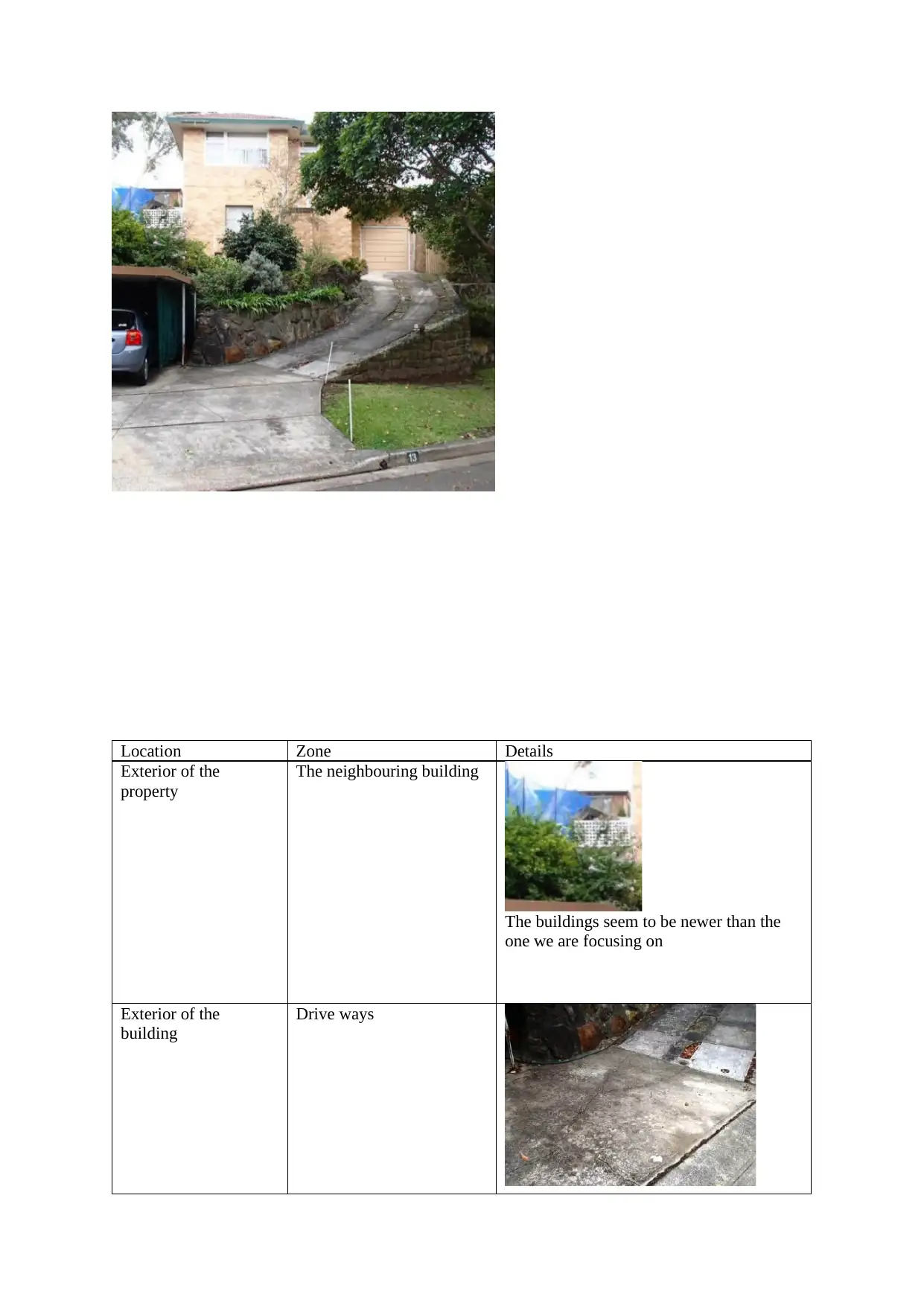
Location Zone Details
Exterior of the
property
The neighbouring building
The buildings seem to be newer than the
one we are focusing on
Exterior of the
building
Drive ways
Exterior of the
property
The neighbouring building
The buildings seem to be newer than the
one we are focusing on
Exterior of the
building
Drive ways
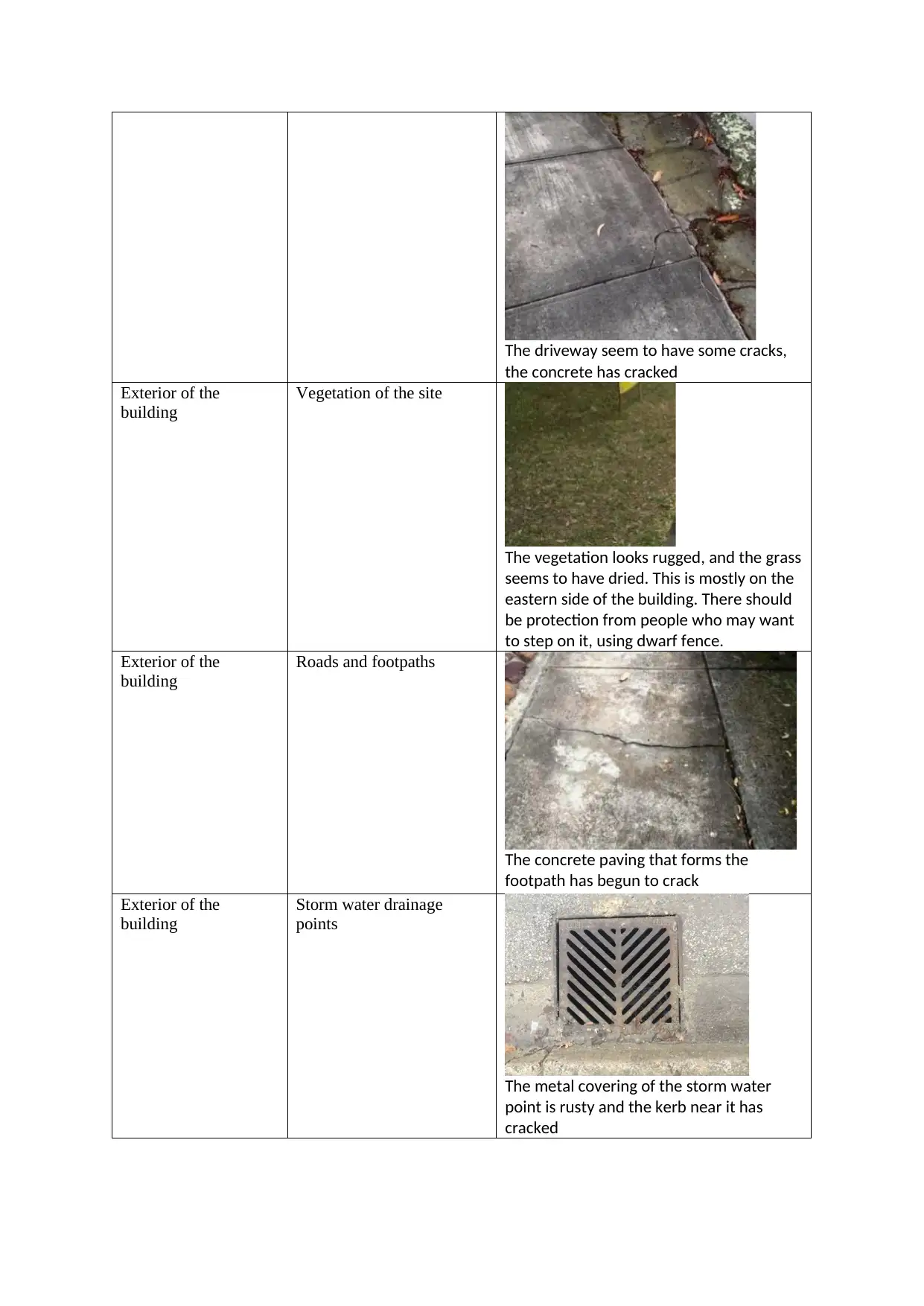
The driveway seem to have some cracks,
the concrete has cracked
Exterior of the
building
Vegetation of the site
The vegetation looks rugged, and the grass
seems to have dried. This is mostly on the
eastern side of the building. There should
be protection from people who may want
to step on it, using dwarf fence.
Exterior of the
building
Roads and footpaths
The concrete paving that forms the
footpath has begun to crack
Exterior of the
building
Storm water drainage
points
The metal covering of the storm water
point is rusty and the kerb near it has
cracked
the concrete has cracked
Exterior of the
building
Vegetation of the site
The vegetation looks rugged, and the grass
seems to have dried. This is mostly on the
eastern side of the building. There should
be protection from people who may want
to step on it, using dwarf fence.
Exterior of the
building
Roads and footpaths
The concrete paving that forms the
footpath has begun to crack
Exterior of the
building
Storm water drainage
points
The metal covering of the storm water
point is rusty and the kerb near it has
cracked
Secure Best Marks with AI Grader
Need help grading? Try our AI Grader for instant feedback on your assignments.
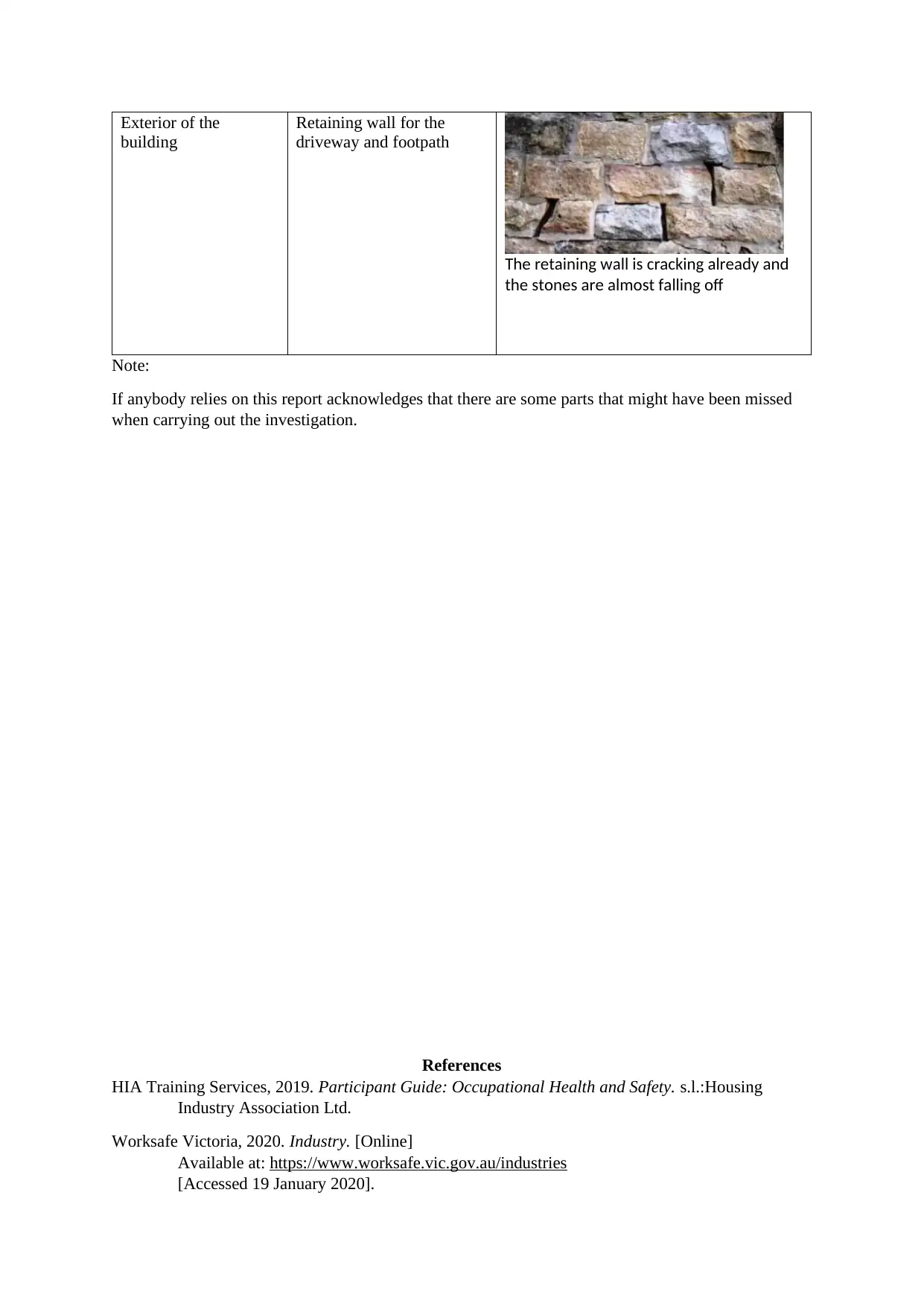
Exterior of the
building
Retaining wall for the
driveway and footpath
The retaining wall is cracking already and
the stones are almost falling off
Note:
If anybody relies on this report acknowledges that there are some parts that might have been missed
when carrying out the investigation.
References
HIA Training Services, 2019. Participant Guide: Occupational Health and Safety. s.l.:Housing
Industry Association Ltd.
Worksafe Victoria, 2020. Industry. [Online]
Available at: https://www.worksafe.vic.gov.au/industries
[Accessed 19 January 2020].
building
Retaining wall for the
driveway and footpath
The retaining wall is cracking already and
the stones are almost falling off
Note:
If anybody relies on this report acknowledges that there are some parts that might have been missed
when carrying out the investigation.
References
HIA Training Services, 2019. Participant Guide: Occupational Health and Safety. s.l.:Housing
Industry Association Ltd.
Worksafe Victoria, 2020. Industry. [Online]
Available at: https://www.worksafe.vic.gov.au/industries
[Accessed 19 January 2020].

1 out of 30
Related Documents
Your All-in-One AI-Powered Toolkit for Academic Success.
+13062052269
info@desklib.com
Available 24*7 on WhatsApp / Email
![[object Object]](/_next/static/media/star-bottom.7253800d.svg)
Unlock your academic potential
© 2024 | Zucol Services PVT LTD | All rights reserved.





